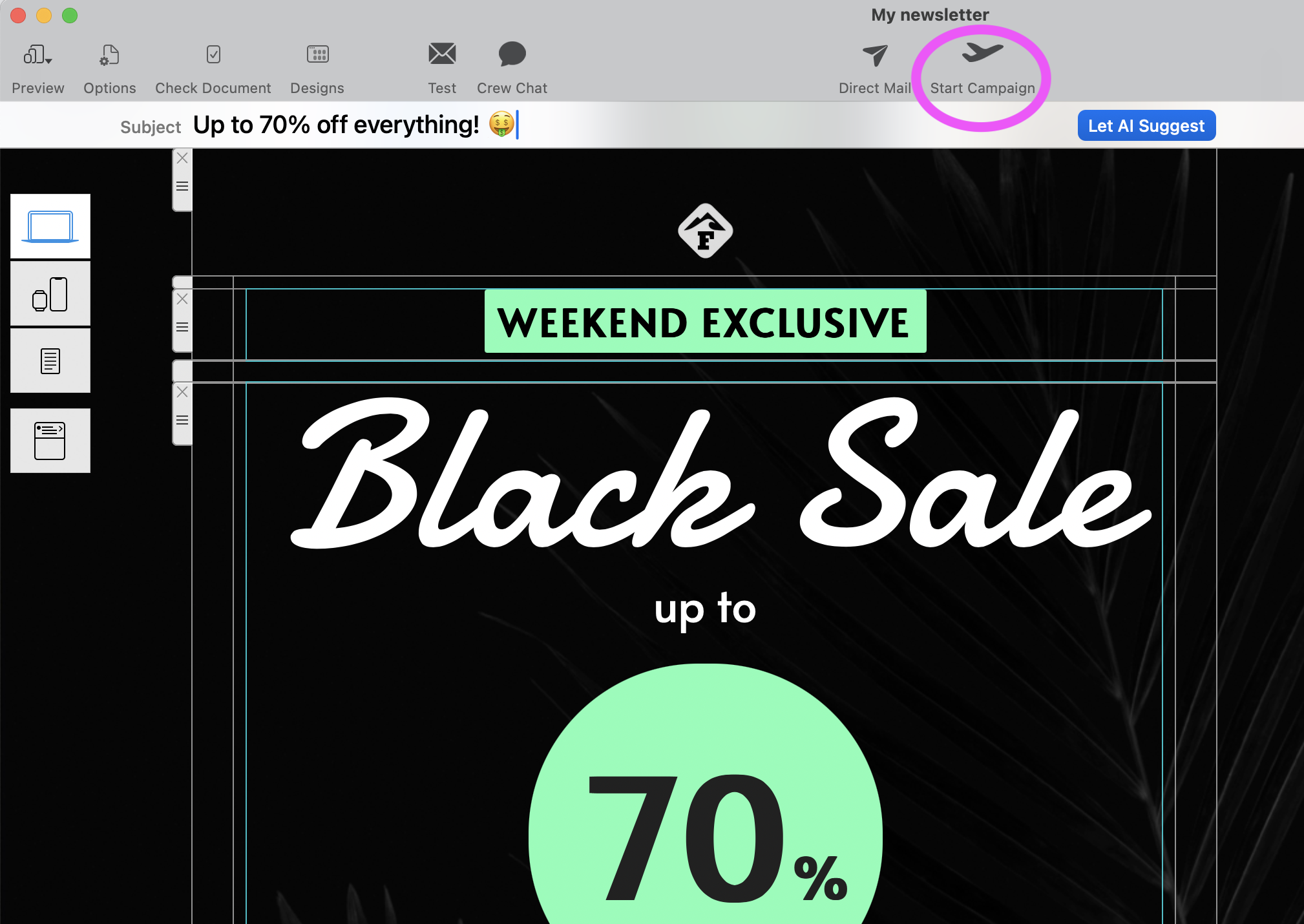



With Google's latest announcement that DKIM is becoming mandatory for mass email senders from 2024 onwards, many email marketers are wondering how to prepare.
The good news: DKIM setup does not have to be complicated. This guide walks you through DKIM setup for your email domain so you can improve deliverability and continue sending authentic, spam compliant email campaigns in the new year and beyond.
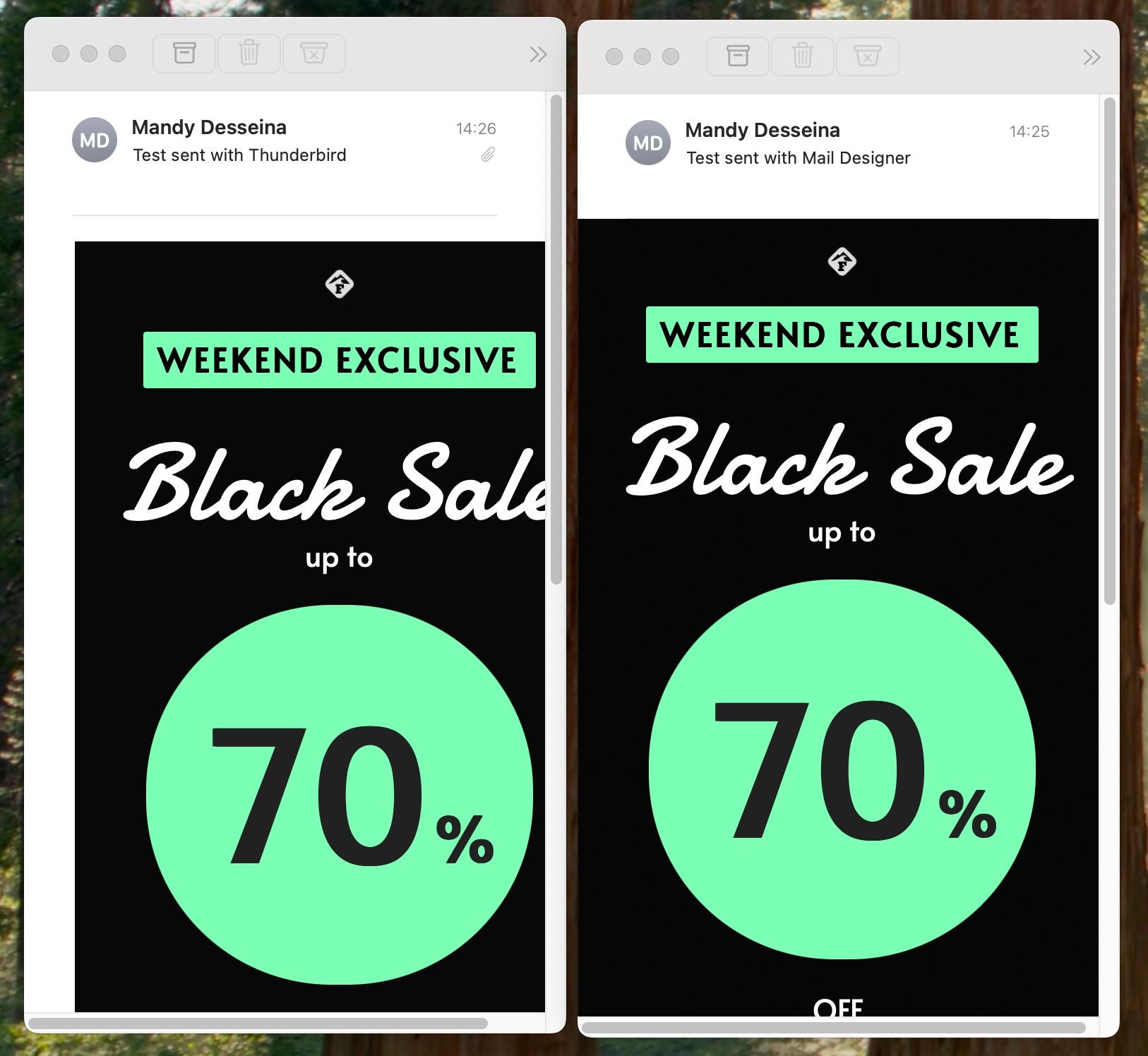
Thunderbird is a popular free email client used by individuals and small businesses around the world. One of the most common questions users ask is whether it’s possible to create and send an HTML email Thunderbird. The short answer is yes — Thunderbird does allow you to use HTML templates. However, once you start designing and sending more professional messages, you’ll quickly run into limitations that make the process frustrating and time-consuming.
Yes — Thunderbird does support HTML emails. You can import a custom template or even write your own code directly inside the editor. For users who just want to test a simple HTML email Thunderbird workflow, this can work fine. At first glance, it looks like Thunderbird could handle newsletters or business updates by using HTML templates. If you want to try it out yourself, follow our step-by-step guide on how to export HTML emails from Mail Designer 365.
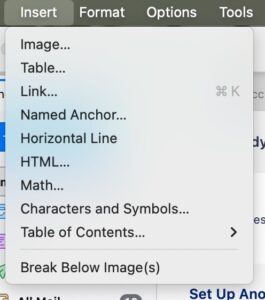
In Thunderbird, you can choose the HTML option from the Insert menu to add custom code to your email.
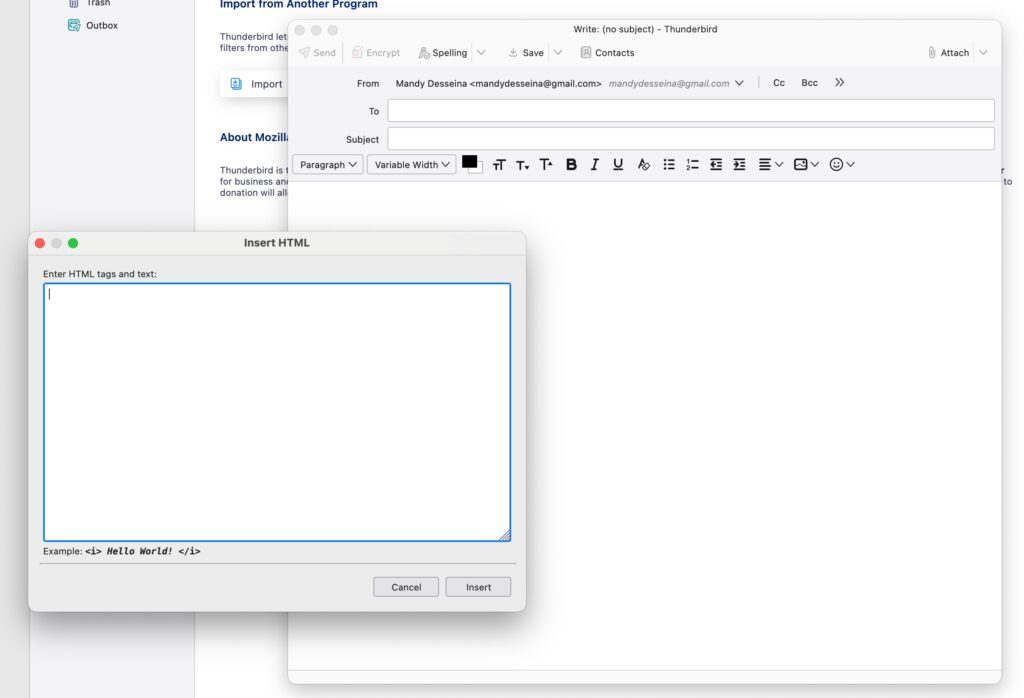
Thunderbird allows you to paste custom HTML code into your message — but editing and formatting remain limited.
When sending out business communications, appearance and reliability matter. Using HTML email in Thunderbird may work for simple messages, but the limitations can cause real problems:
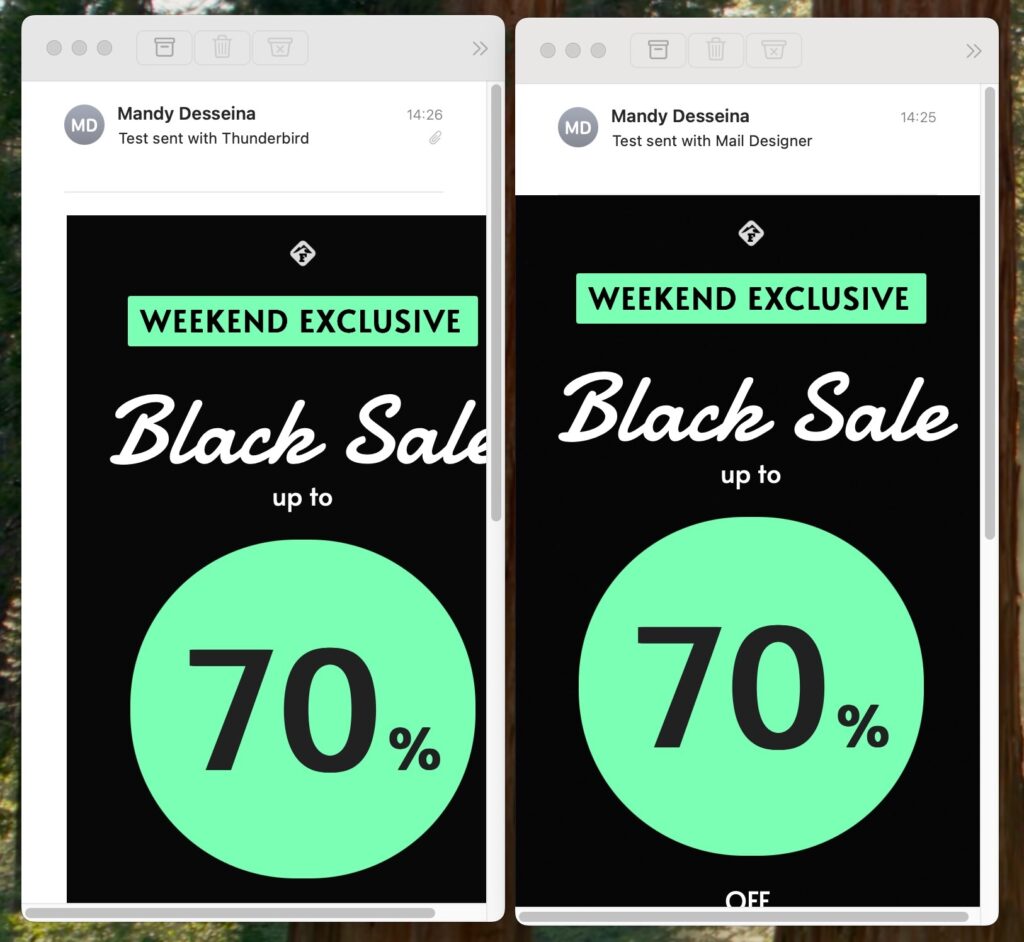
The same HTML email sent with Thunderbird (left) shows formatting issues and requires image attachments, while Mail Designer 365 (right) delivers a clean, professional result.
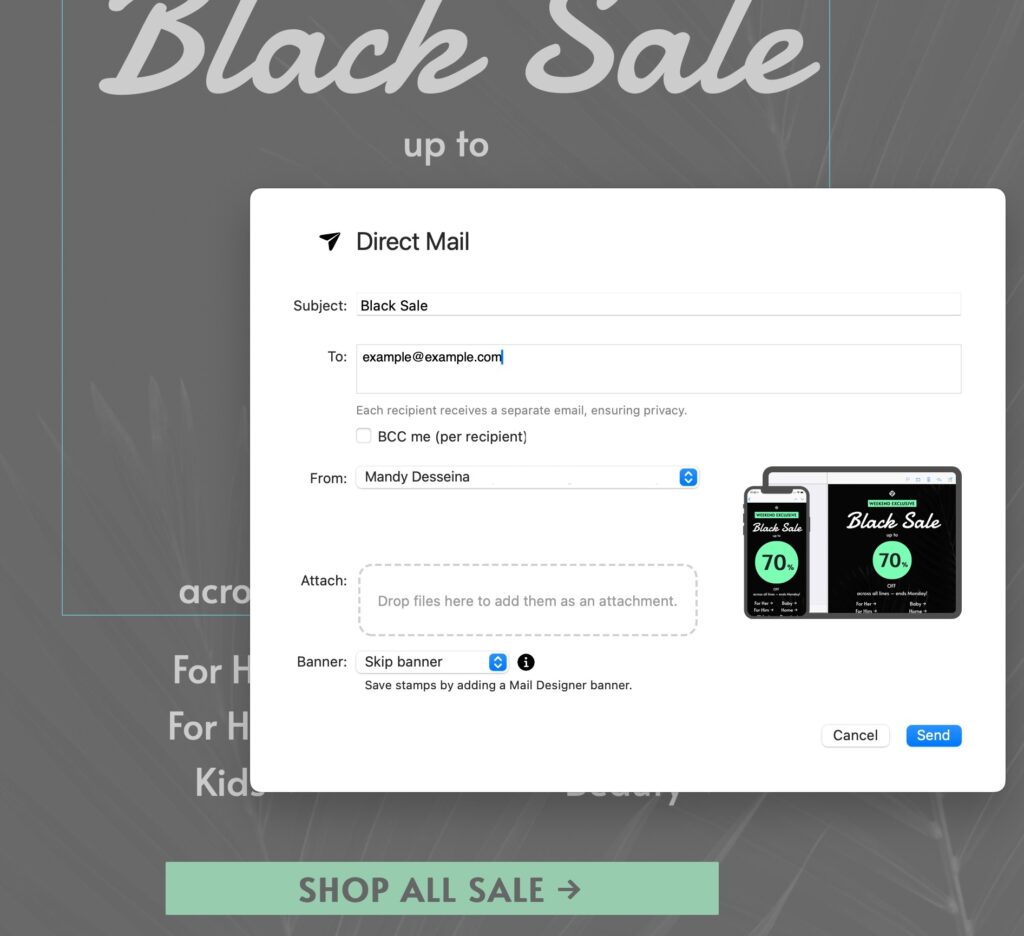
With Mail Designer 365 Direct Mail, you can send professional HTML emails directly from your Mac — without broken layouts, missing images, or large attachments.
Creating and sending HTML email Thunderbird is technically possible, but the experience is far from smooth. From broken layouts to constant image reconnecting, Thunderbird’s limitations make it difficult to achieve a professional result.
If your goal is to send emails that look polished, work reliably across devices, and provide insights into performance, Thunderbird will quickly feel restrictive.
That’s where Mail Designer 365 comes in. With powerful design tools and the integrated Direct Mail function, you can create beautiful HTML emails and send them directly — without the headaches.
Try Mail Designer 365 today and experience a better way to design and send professional emails.


Although they aren't as flashy as the sales email, well-designed transactional email templates are, without a doubt, the cornerstone of your email marketing strategy. Building an automated email strategy based on just a few transactional email templates will not only save you time, but also help you achieve important marketing goals for your business.
Transactional emails are triggered by customers carrying out certain actions, reaching specific milestones, or completing events which you deem important to your business. Because of the clear cause-effect relationship, it's easy to integrate these types of emails into your standard marketing strategy to specifically target certain types of customers.
Here are 5 easy-to-implement use cases for the humble transactional email that you can adopt for your email marketing arsenal to drastically improve your business's performance in multiple areas.
Mastering the onboarding process is crucial for any business; making your welcome email one of the most important you will ever send.
Sending out an email when a customer signs up to your newsletter or creates an account for your service is a great way to welcome them into your community. Here are three key things to include:
Use the welcome email to introduce new customers to your business and show them how to get started.
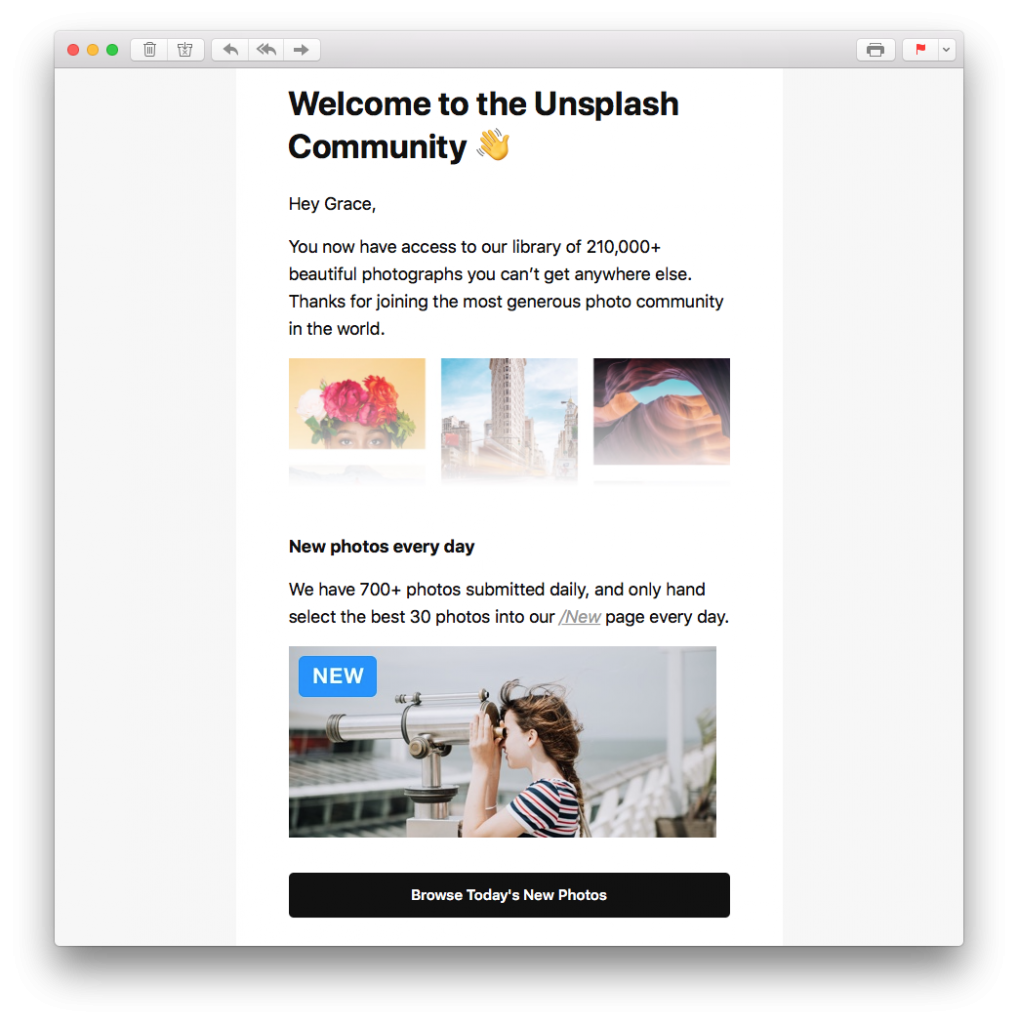
This welcome email from Unsplash ticks all the right boxes and shows users how to get started browsing the latest photos straight away.
Whether tangible products, software, event tickets, or something else, if your business is selling something, you need to include the purchase confirmation email as one of your transactional email templates.
When making an online purchase, customers naturally seek more reassurance than in a physical store where there is a clear exchange of goods for money. A purchase confirmation email acts as a receipt and also confirms to the customer that their transaction was completed successfully.
Be sure to include all of the important information including product ordered, price, payment method and delivery date so that the customer has this for their records. It is also a good idea to include your contact information in case the customer has any questions about their order.
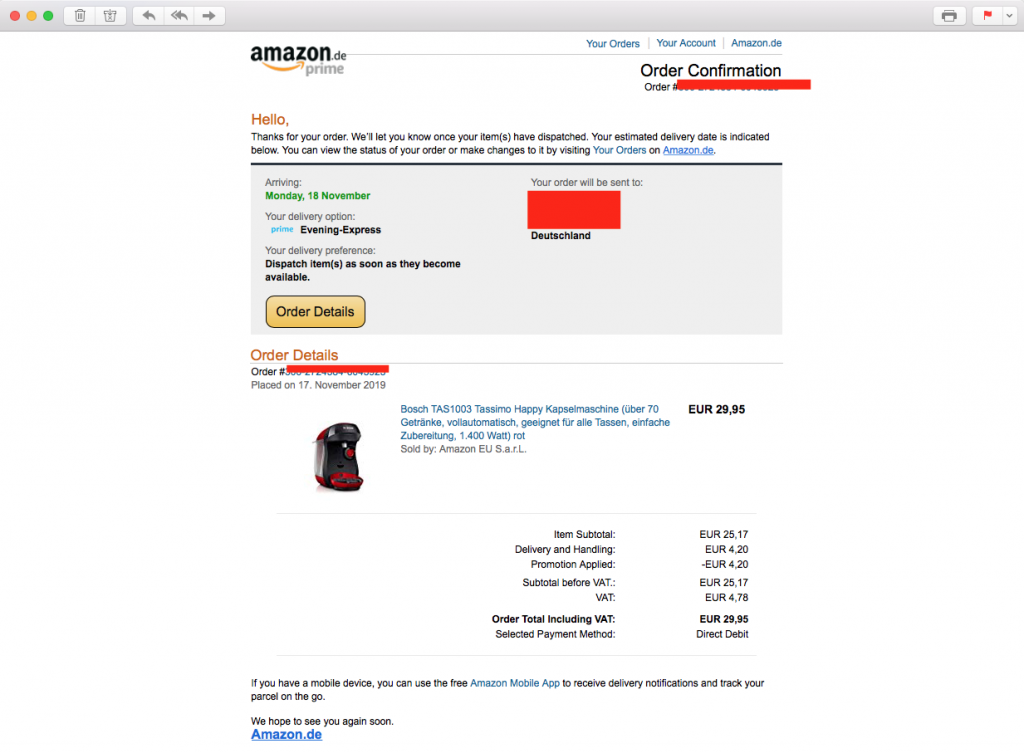
This email by Amazon contains all the most important information the customer needs concerning their purchase.
The subscription model is becoming more and more popular. Take Netflix, Spotify, Adobe, etc. as an example. Because many of us use so many different subscription services, it is a good idea to remind users when it's time to renew their license for your product. Not only is this a helpful gesture, it also helps prevent you losing out on customers because they've forgotten to renew.
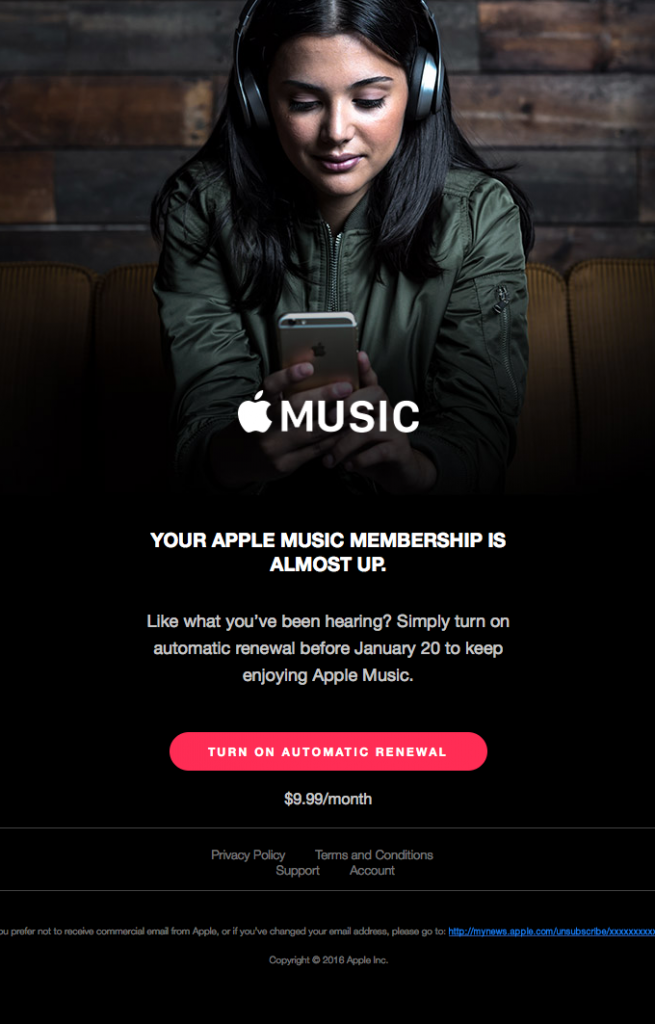
Apple Music keep things short and simple in this renewal prompt. The CTA (call-to-action) button also takes the customer right to where they need to go.
Many services auto-renew without the customer having to do anything. It is also important to remind your customer that their auto-renewal is about to occur, as they may wish to make changes to their subscription details. You'll definitely thank yourself later when you're not receiving complaints and refund requests.
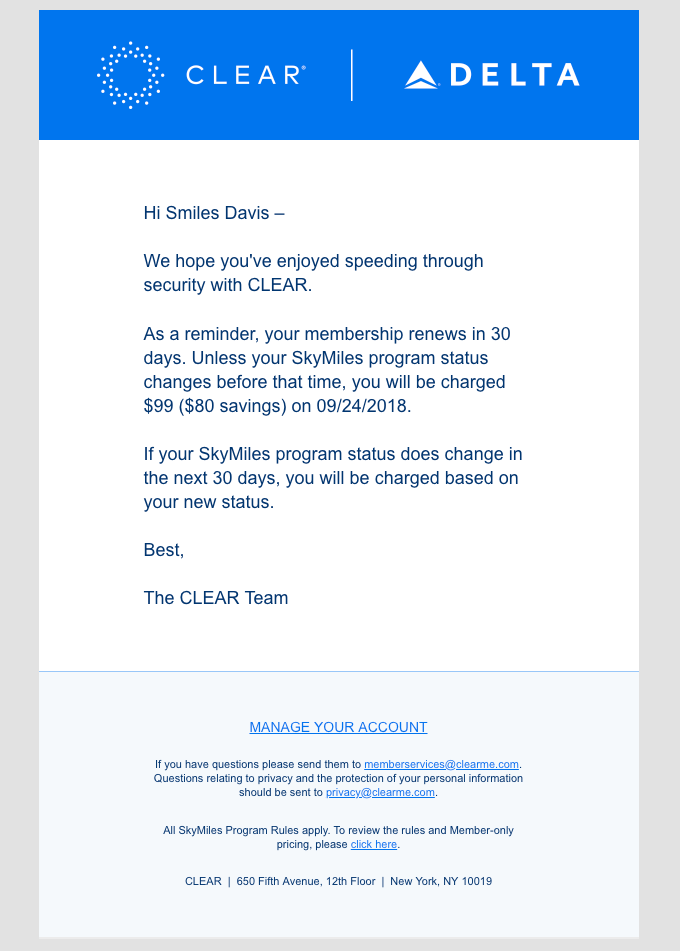
As shown by Clear, reminding your customer about auto-renewals is not only the decent thing to do, it also helps to reduce complaints and refund requests later on.
We've talked about this in detail before, but an abandoned cart email is also a super important part of your transactional email strategy.
Rather than missing out on potential sales opportunities, make sure to encourage re-engagement wherever possible. Keep track of incomplete transactions and send out a friendly reminder to your customer to pick up where they left of.
In many cases, customers may have simply become distracted or forgotten to finish their order. Even if just a small percentage choose to resume their purchase, sending an abandoned cart email is a good way to maximise all potential sales opportunities.
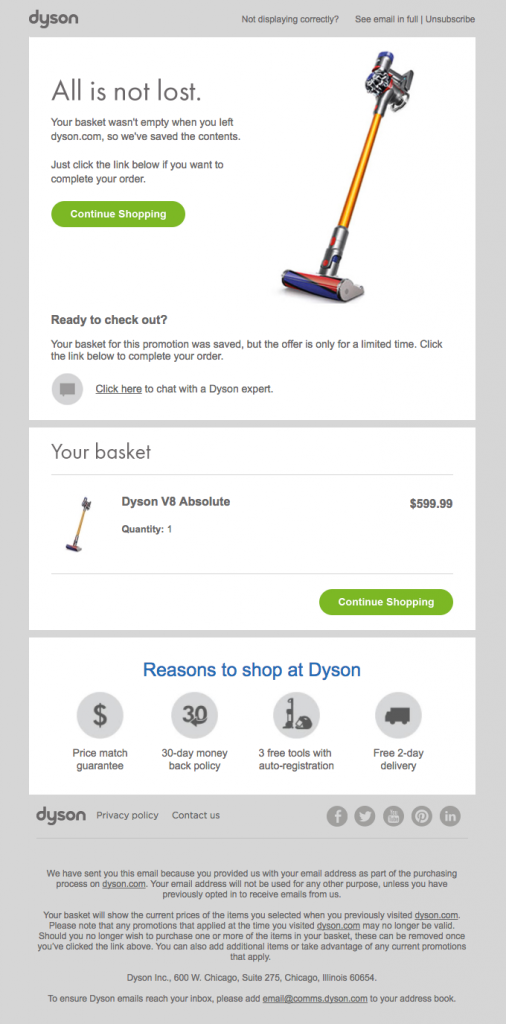
Dyson make it easy for customers to continue shopping with a bright CTA. Including the key product details is also a good way to help jog the reader's memory.
Feedback is the key to optimising your business to suit your customers' needs. For this reason, including some form of feedback request in your transactional email collection is also a good idea.
Here are a few examples of things customers could do which may trigger the need for you to collect feedback from them:
Sending customers a quick request for feedback after they've carried out certain events is a good way to determine how to improve your product or service for your target audience. The key to a good feedback email is to keep things concise and to send on time so the experience is still fresh in the customer's mind.
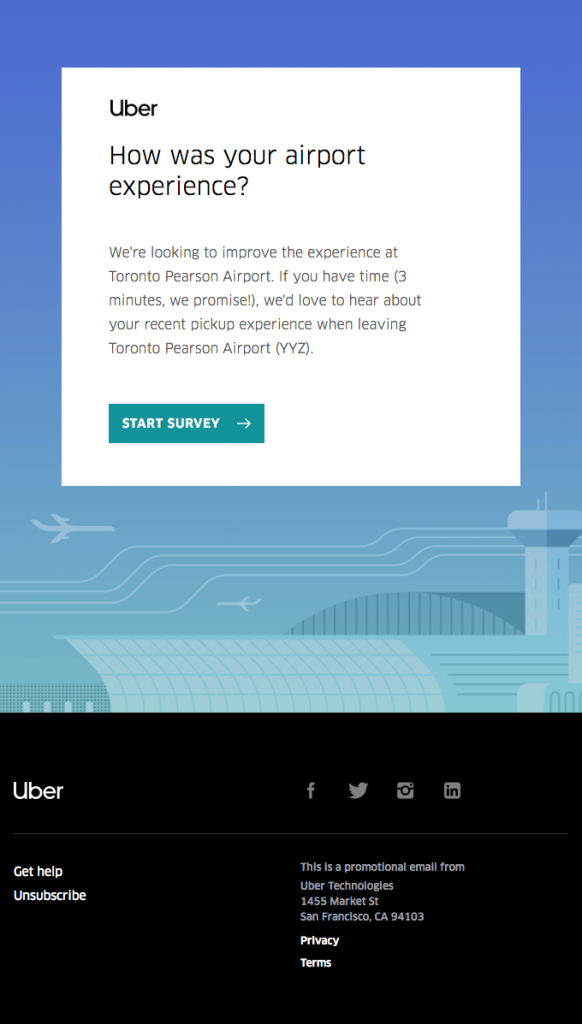
This email by Uber is nicely worded and allows the customer to give them a direct response about a specific topic.
As well as a stylish selection of easy-to-adapt, ready-made transactional email templates to fit all these use cases, Mail Designer 365 also provides you with all the creative tools you need to design effective transactional emails from scratch.
This post shares some important tips about what to include when designing your own transactional email templates.
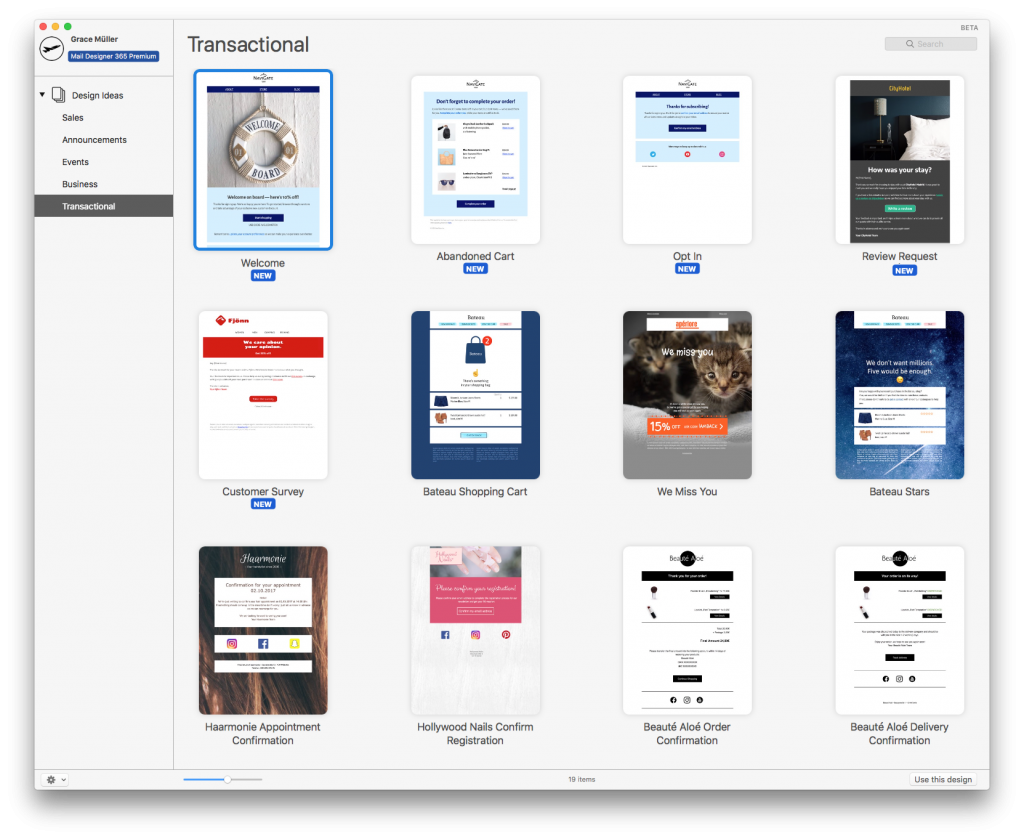
Mail Designer 365 offers you an array of ready-to-send transactional email templates.
Once your transactional email template is ready, you have a variety of options to get it to your recipient:
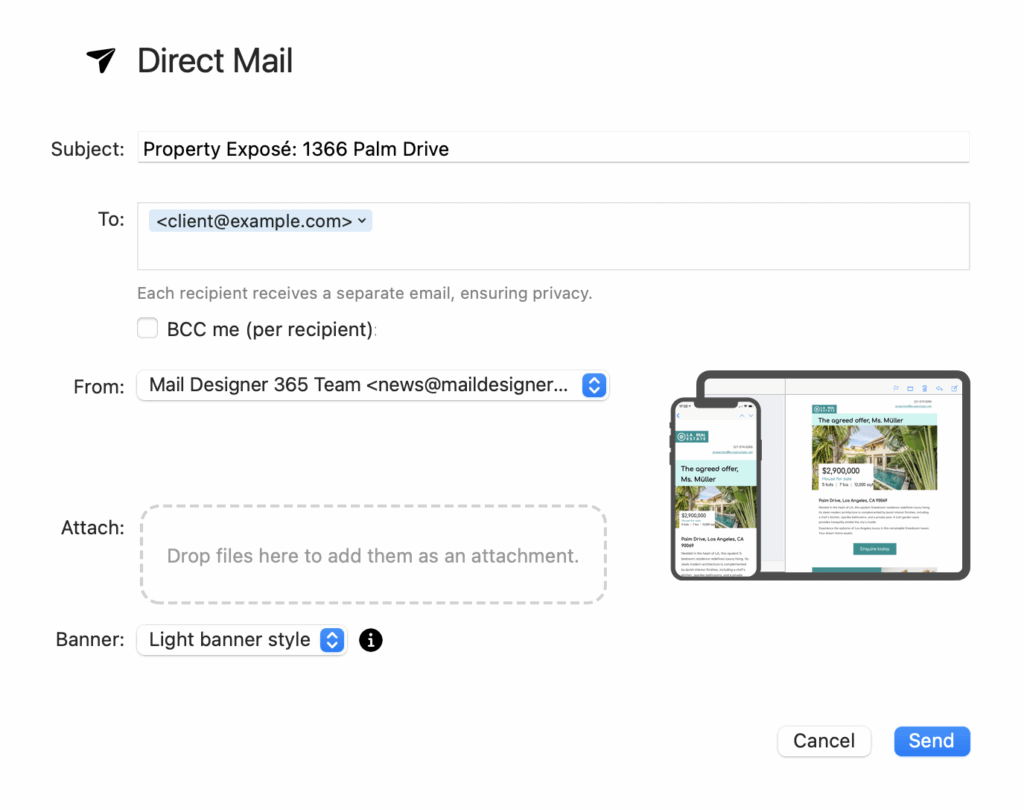
Directly send transactional email templates to customers

Email marketing for e-commerce is a cost effective way to reach new customers and grow your business. With the number of e-commerce stores rising and online shopping being more popular than ever, it's important for small businesses to do all they can to promote their store.
With email marketing, businesses of all sizes can directly connect with customers and drive more traffic to your store. In this guide, you'll find tips and ideas on how to get started with email marketing for your small business or optimize your existing email strategy.
Although marketing strategies like paid ads, SEO and social media campaigns are all effective in their own way, they can't guarantee you a direct channel to customers. Email presents you with the unique chance to speak to your audience on a one-to-one level and create personalized content for them.
Especially in retail, customer loyalty is a strong success factor. Most businesses rely on customers returning to provide a steady stream of sales. Email is a great tool for maintaining relationships with repeat customers and keeping them engaged with your business over time.
As long as you have an idea of your goals and knowledge of best practice, email marketing for e-commerce is really straightforward. All you need to get started is an email list, a set of email templates, and a sending service like Mail Designer!
The first step in getting started with email marketing is collecting email subscribers for your list. This is also known as email lead generation.
One common way for e-commerce websites to gain email subscribers is through collecting email addresses at the point of sale. Inserting a field on your online checkout for shoppers to enter their email address allows you to stay in touch with them following the sale.
Important: Remember that data privacy regulations in most countries also require the customer's consent for receiving marketing emails. Make sure you research the opt in requirements in your country before setting this up.
While the above method provides you with contact information for existing customers, it doesn't take into account those who haven't purchased from your store. Here are a few organic ways to collect more email addresses for your list:
This is a popular method for many businesses. Build an opt in form for your website to allow customers to subscribe to your list for regular news and updates. These kind of sign ups are the most valuable, as they are customers with an active interest in your business.
Some good places to include an opt in form are: the footer area of your website, on your "contact" or "about" page, or as a header bar at the top of your site.
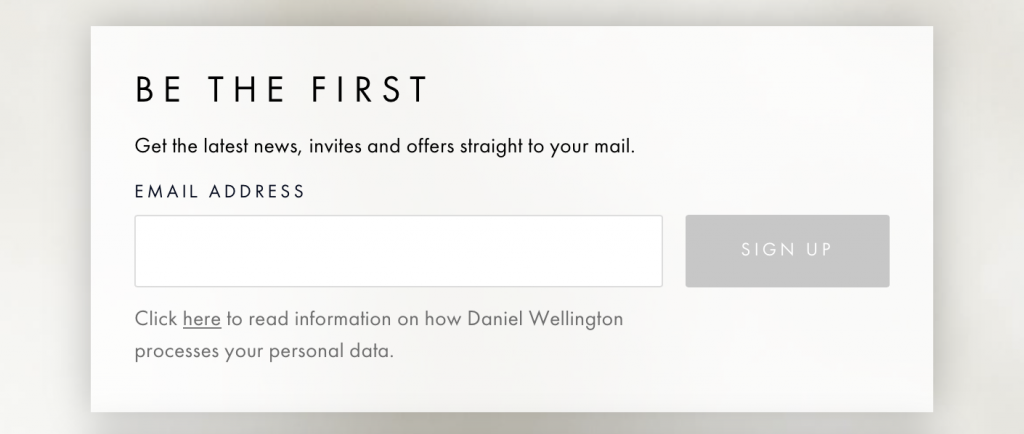
Daniel Wellington display this email opt in form at the bottom of their website.
Tip: Mail Designer Delivery offers an integrated form builder so you can easily insert sign up forms into your website. Learn more.
Offering customers an incentive in exchange for providing their email address can also be effective. One way of doing this is through a discount or promotion. For example, many websites offer new customers money off their first purchase if they enter their email address.
Although this could be part of a regular sign up form, it can be even more effective as an eye-catching pop up window.
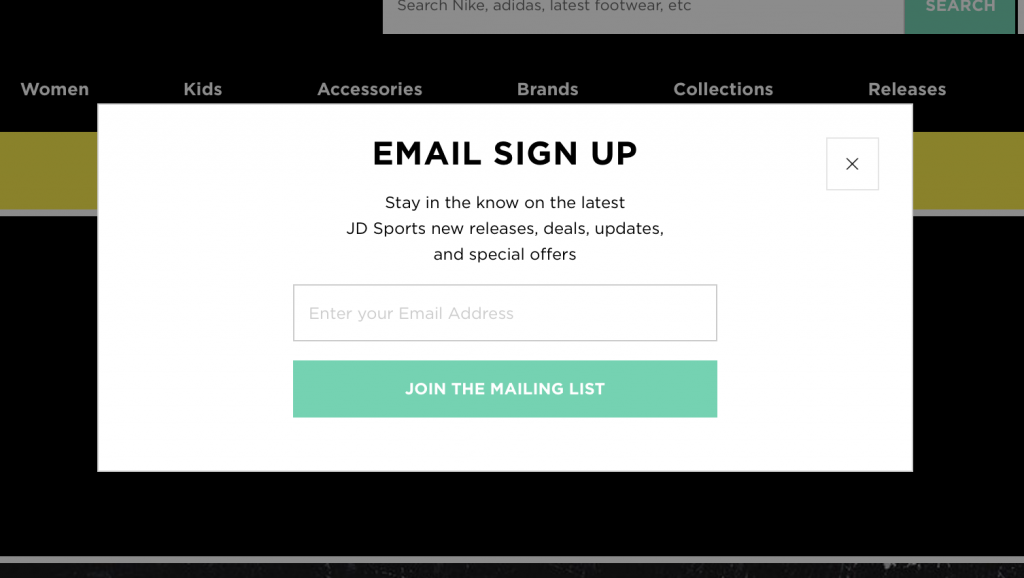
JD Sports use a popup window to encourage website browsers to sign up to their email list.
Tip: Set your popup to appear to new customers after a few minutes of browsing. This way, you'll know they have an interest in your store.
A giveaway or competition is another fun way to increase email signups and get more people engaging with your store. Set up a dedicated landing page where participants can enter their email address for a chance to win.
Tip: Use your social media platforms to promote your giveaway and encourage more people to take part.
If you have products which are out of stock, use this as an opportunity to encourage more newsletter sign ups. Create a dedicated sign up form for sold out items which customers can use to get notified when the product is available again.
Tip: Use this sign up data to see which products customers are interested in and offer an alternative.
When it comes to the types of emails you can send for your e-commerce site, you have a wide range of options. Split your emails into two main categories: automated, transactional emails for everyday use and one-time promotional campaigns. Find out more about each of these below.
Transactional emails cover the emails a business need to send on a day-to-day basis. They are sent out when a customer performs a certain action or trigger (e.g. making a purchase.) For an online store, this will most often be order confirmation emails and delivery updates.
Every business is unique. Think about your store's general workflow and come up with a set of functional, on-brand templates to simplify this process. This article offers some great tips on how to do this. Once you have created your email templates, you can set them up to use with your automation tool of choice.
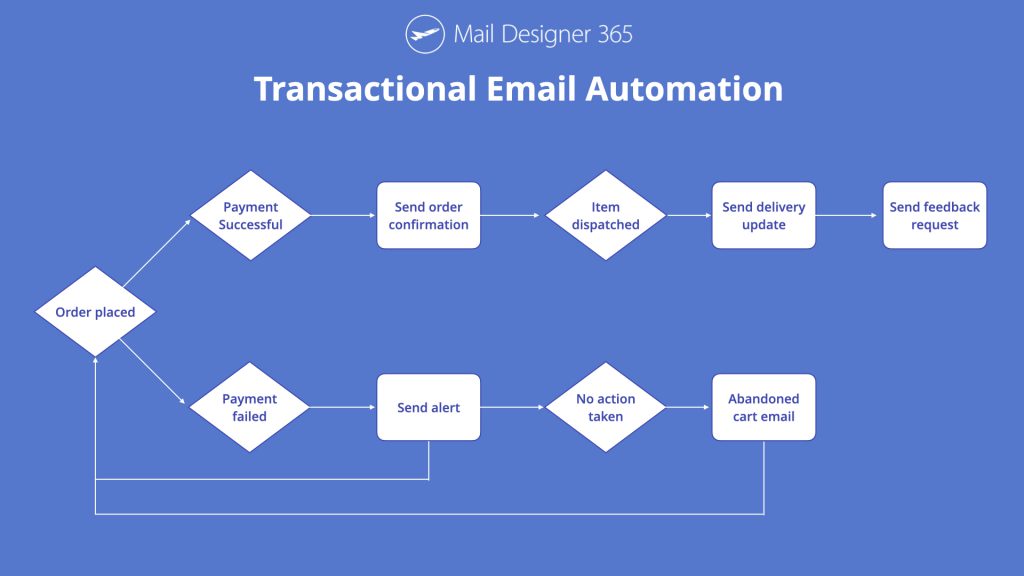
Here is an example automation flow for transactional emails to use for your online store.
Tip: Over time, you can optimize your strategy and add more and more templates to respond to different triggers. Here are some more great ideas for transactional emails.
Promotional email campaigns are also a major part of your email marketing strategy. These campaigns help you generate revenue and get more traffic to your store. As one-off campaigns, it will take a little more work to make them stand out and excite customers, so good design is key.
Here are some examples of email promotions you can run for your online store:
A seasonal sale is a classic choice for any online retailer. Announce your sale to email subscribers and watch your website traffic skyrocket, as customers try and get hold of a great deal.
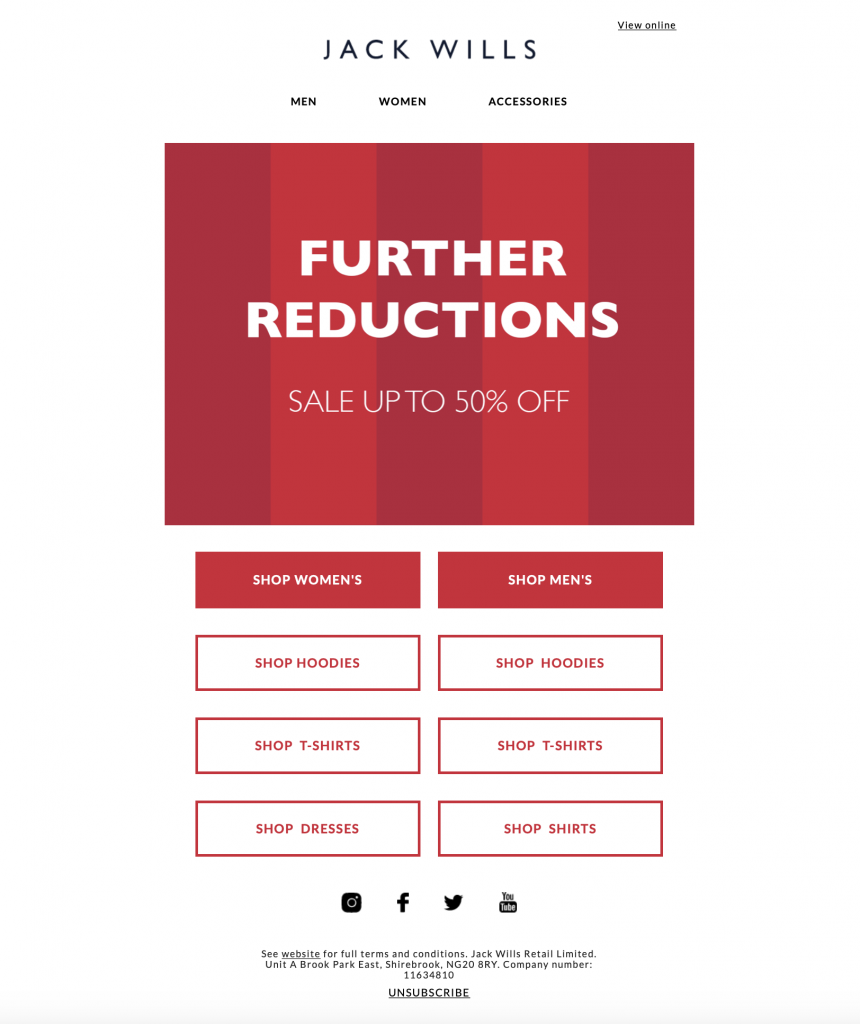
Sale email by Jack Wills to advertise their summer sale to customers.
Tip: Make sure to generate a sense of urgency in your email by using time sensitive language. This plays on customers' FOMO (fear of missing out) and helps ensure they check out your sale faster. When it's gone, it's gone!
Tempt subscribers with your latest products and send an email to announce new stock in your store. Whether it's a new product range, exciting collaboration or restock, your customers will want to know.
Staying relevant is really important for your small business's survival. Even if you have nothing new to share, you can engage customers by showing them new and creative ways to use your products.
Similarly to a sale, running a promotion is also an effective way to tempt customers onto your e-commerce site. A promotion can come in many shapes and sizes, covering everything including: free delivery, x% off, free gift with purchase, etc.
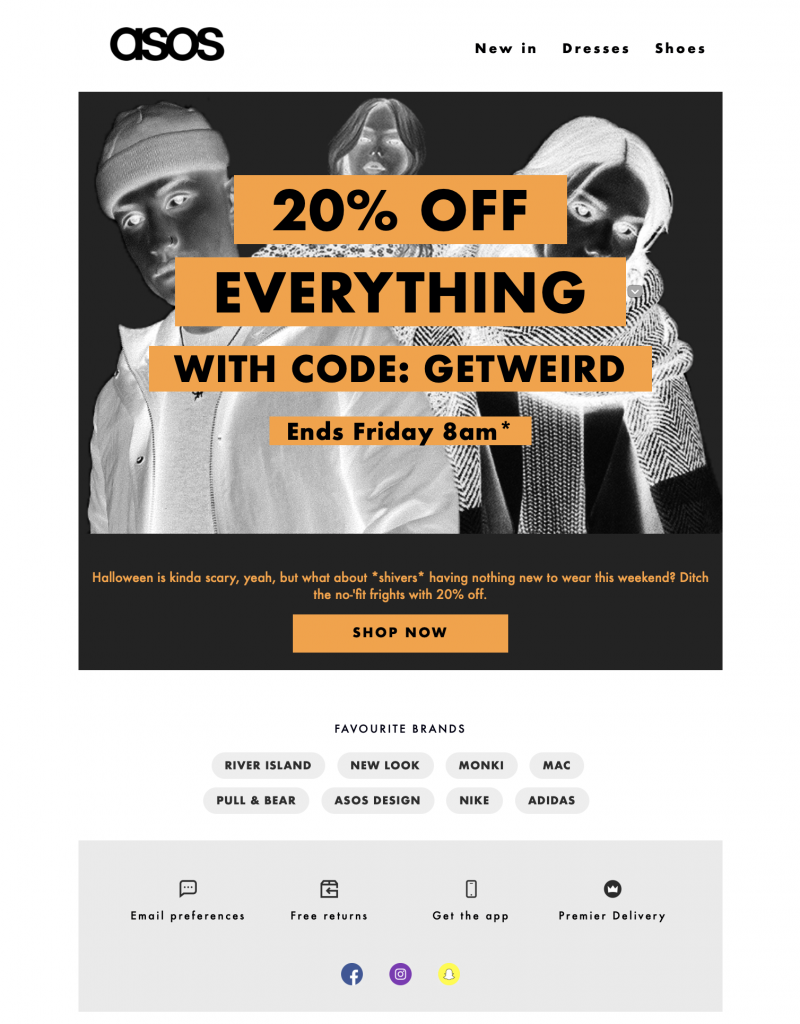
Halloween promotional email by ASOS.
Tying in a promotion with a certain theme or event is a good method in making it more relevant to your customers. As well as popular seasonal holidays like Halloween, Thanksgiving and Valentine's Day, there are also a number of alternative occasions throughout the year which provide a great opportunity to hold a promotion with less competition from other brands. Here are a few ideas:
Tip: Running promotions too regularly can often be detrimental to your business, as they will lose their exclusivity and also deter customers from purchasing at full price on a regular day.
If you have a blog, this can be another good tool to use to get more visitors to your online store. Curating your latest blog posts and sending them to subscribers alongside fun product recommendations and other news can make for a great newsletter.
Your subscribers signed up because they are interested in your business. Informative, content-based emails are often a welcome break from a sales heavy strategy. It's good to balance out your content every now and again.
Blog topics could include industry news, smart ways to use your products, step-by-step tutorials, or personal stories about your products or business.
Now you have an idea of which emails to be sending your customers, you should briefly familiarise yourself with these five, specially selected best practice tips. This helps ensure your marketing emails are effective and will result in more conversions.
Your email subject line is your first chance to make an impression on your reader. Oftentimes, if the subject line is not interesting enough, the email will be left unread.
When writing your email subject, you should try your best to ensure it is entertaining and also effective in communicating the contents of the email. Advertising a summer sale? Make sure you use these keywords in the subject line! Emojis can also be a great way to make your subject even more striking.
Tip: Mail Designer 365 has a built in inbox preview tool. Use this to keep control of the length and get a feel of how your email subject will look in your recipients' inbox.
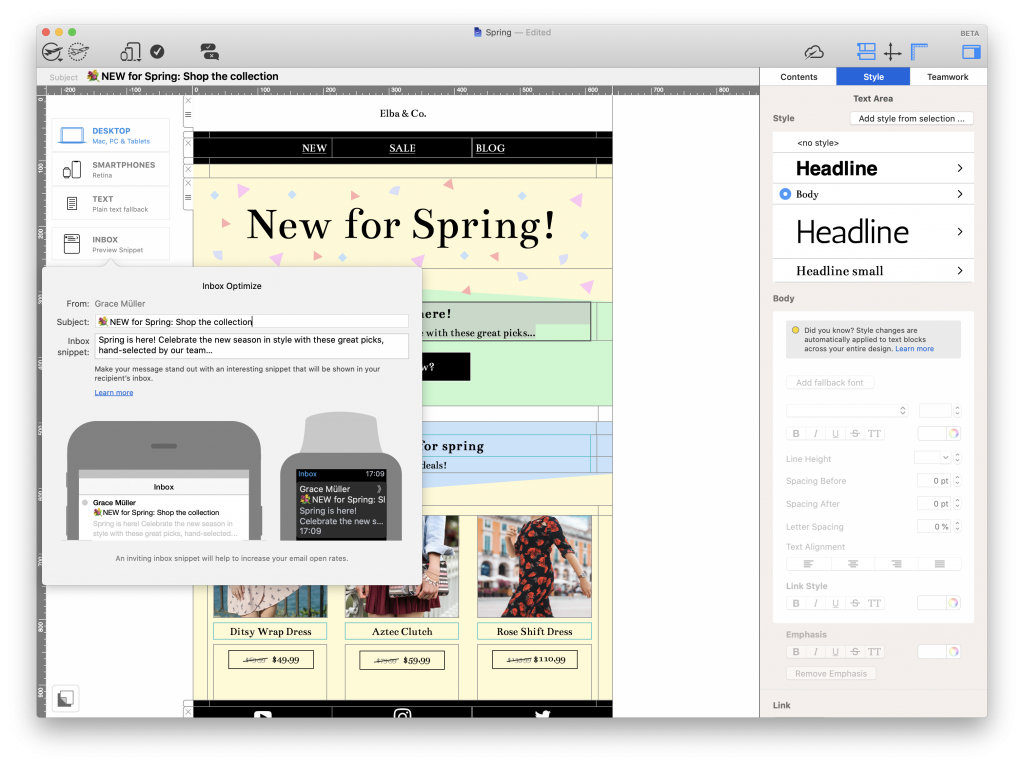 Sales layout
Sales layoutMost of your promotional emails will be advertising certain products. To make these easier to shop, you should make sure your email layout is practical and easy for readers to navigate.
In addition to good quality product photos, remember to also include a product name and up to date price tag. This helps customers a lot in the shopping process. As well as this, a direct and accurate link to the product is also essential, as customers will quickly lose interest if they are unable to find what they are looking for.
Where possible, you should also ensure that your email layout reflects your store's layout in the best way possible. Consistency is key and helps streamline the transition between your emails and your website.
Tip: Mail Designer 365 offers 1000s of layout combinations which you can use to recreate the look and feel of your store in your email designs. Drag and drop to build.
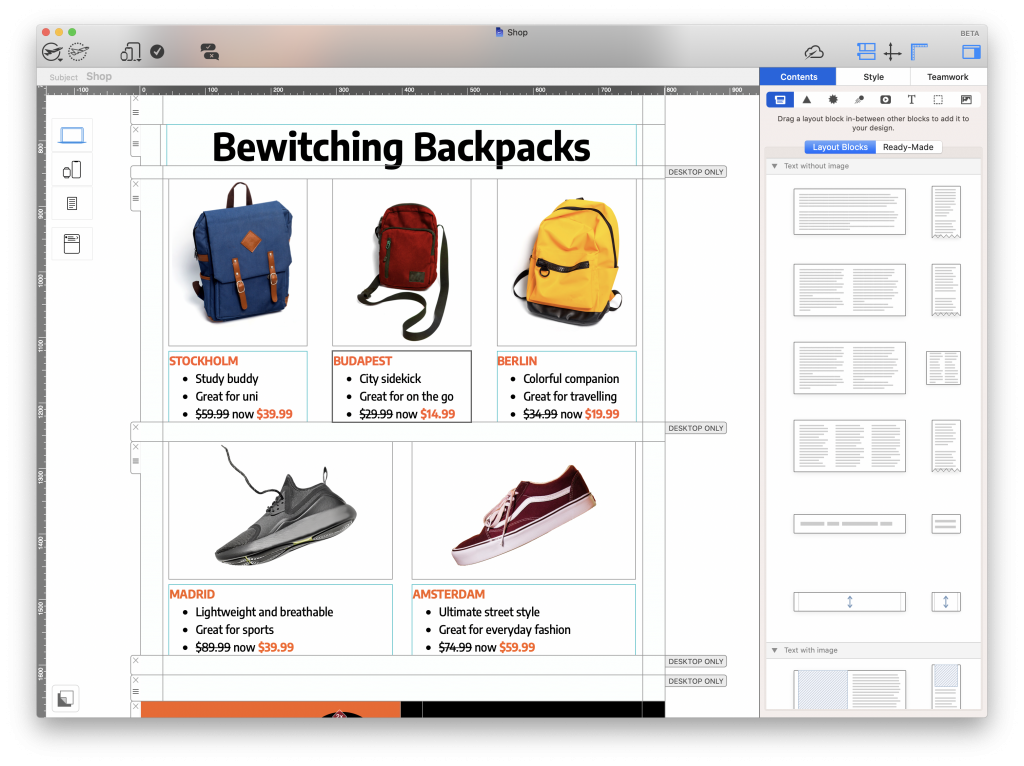
Having a clear call-to-action (CTA) is a must in every email. Your CTA points the customer to their next step and is a critical factor in securing more conversions.
If you have a great email design but no clear next step, your customer will quickly become disengaged and move on. Use a bold CTA button to link to a specific product, to your sale page, your blog, or another destination.
Mail Designer 365 supports the use of text buttons for ultimate compatibility in all email clients. Learn more.

Inserting a text button in Mail Designer 365 is easy
Just like your online store needs to be mobile friendly, so do your emails! Having great email content for smartphones and other mobile devices is an important part of the user experience for many of your customers.
Tip: Mail Designer 365 automatically creates a mobile responsive version of your email design that you can edit separately in the smartphone view.
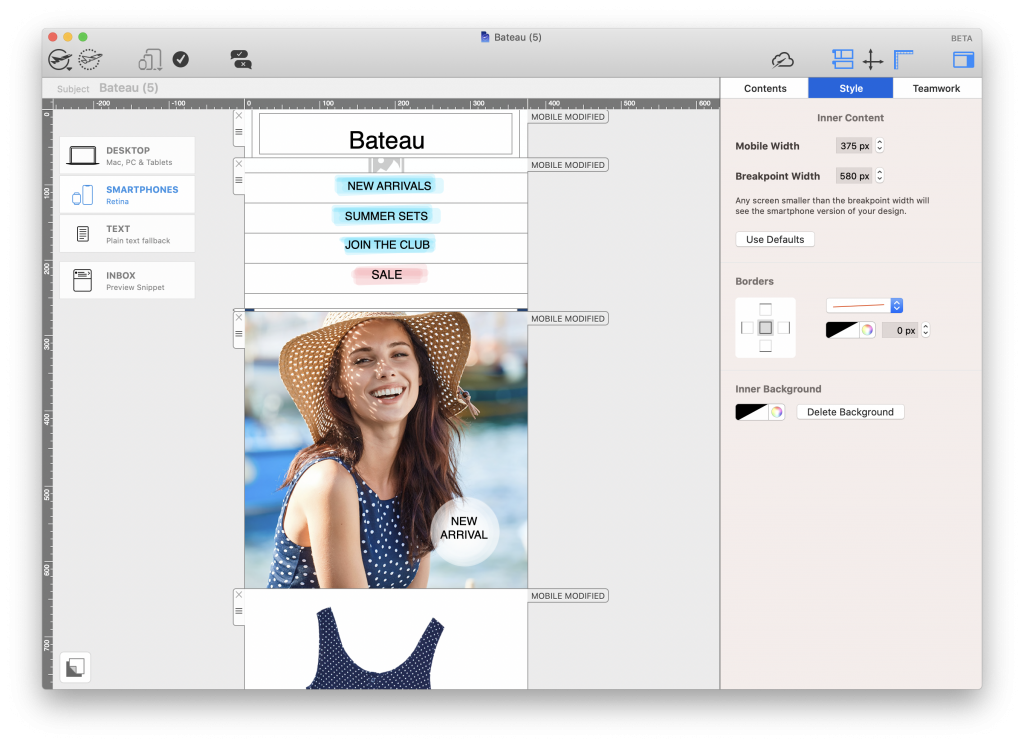
By law, you are required to include an unsubscribe link in every promotional email. This allows subscribers a way to opt out of your list if they are no longer interested.
The email footer is the most common location for an unsubscribe link. When you do set this up, it's best practice to make it well-visible, as not to deceive customers and make things difficult.
Remember, subscribers removing themselves from your list is not all bad. Your goal is to send emails to customers with a genuine interest in your business. With fewer disengaged subscribers on your list, you can hope for better open and click rates in the future.
Hopefully, this guide has shown you the benefits of email marketing for e-commerce. Getting started with an email marketing strategy for your e-commerce business is super straightforward:
For more useful resources on getting started with email marketing for e-commerce – including setting up email target groups, scheduling campaigns, and managing email contacts, check out the Mail Designer 365 Manual.
Get more inspirational tips, tricks, and best practice examples in the Mail Designer 365 Newsletter Academy -
your one stop hub for all things email marketing strategy and newsletter design.

Email marketing for schools is a flexible and effective communication channel — especially for schools and universities. Whether you’re sharing internal updates, contacting recent graduates, or reaching out to potential new students, email marketing helps you connect with your audience in a targeted and meaningful way.
If you’re looking to get started, on our page for email marketing for higher education you will find everything you need to create impactful, professional emails that reflect your institution’s brand.
In this post, we’ll walk you through the key steps to building a successful email strategy for your school or university — from planning and content ideas to design tips and best practices.
Email marketing for schools is a cost-effective and powerful way to enhance communication with students, parents, teachers, and staff. Beyond saving your institution thousands of dollars each year in printing and postage costs, it offers a modern, easy-to-implement solution to streamline your outreach efforts.
In today’s digital age, students and educators frequently check their smartphones, tablets, and laptops throughout the day. Email provides a direct, reliable channel to reach your school community instantly — whether you’re sharing urgent updates, upcoming events, or important announcements.
Moreover, email marketing allows schools to deliver personalized messages tailored to different groups, such as parents, students, and faculty, improving engagement and building stronger relationships. This direct communication boosts transparency, fosters trust, and encourages active participation in school activities.
With email marketing for schools, you can also automate routine communications like enrollment reminders, newsletters, and event invitations, freeing up valuable administrative time. And thanks to detailed performance tracking, you can continuously refine your campaigns to ensure your messages resonate and make an impact.
Track email open rates, click-throughs, and engagement to refine your campaigns and ensure your messages resonate with your school community.
Email marketing for schools goes far beyond flashy sales messages — it’s a powerful tool to improve internal communication and connect with students, parents, staff, and alumni in a targeted, cost-effective way. Here are the most impactful email campaigns your school, college, or university should consider using:
Most institutions are already familiar with newsletters. Switching from printed to email newsletters lets you share school updates, event highlights, and important announcements — while saving on printing costs and reducing your environmental footprint.
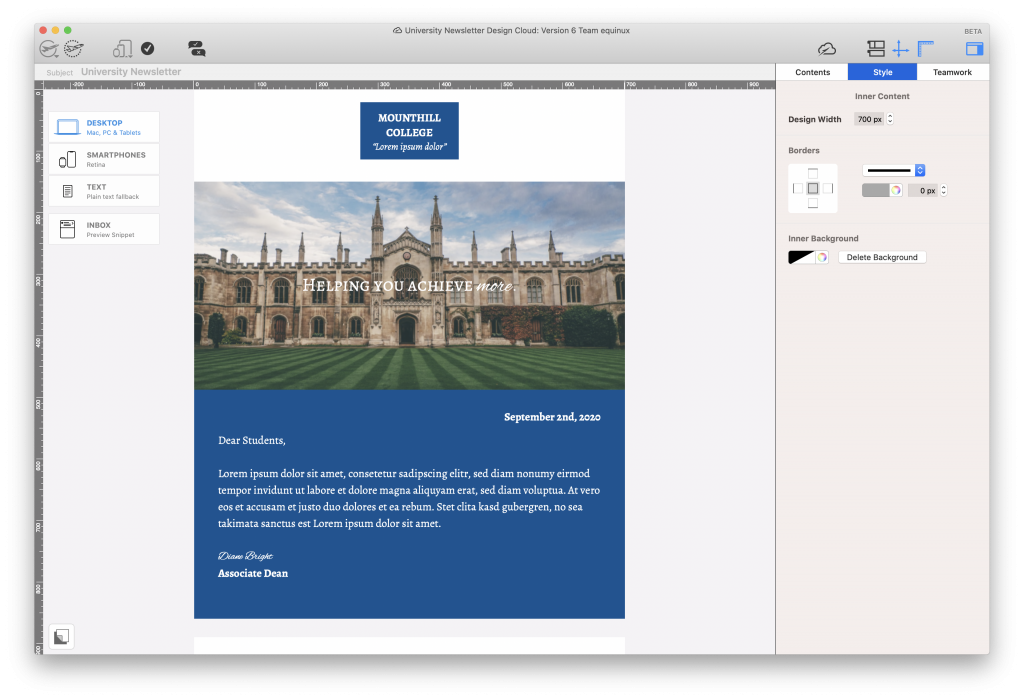
Start-of-year communications can be overwhelming. A well-designed orientation email helps students feel informed and supported from day one, with easy access to schedules, campus maps, key contacts, and must-know info.
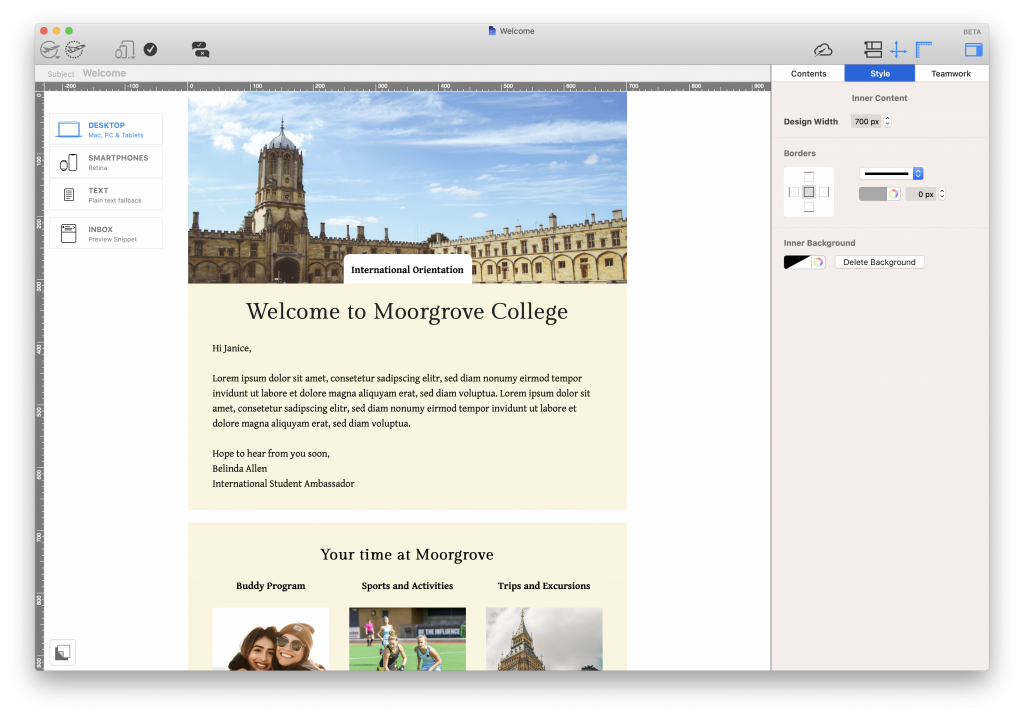
Email is a great way to gather honest feedback from your school community. Instead of printed slips, send a quick, mobile-friendly survey (e.g. via Google Forms) and use responses to improve courses, events, or campus life.
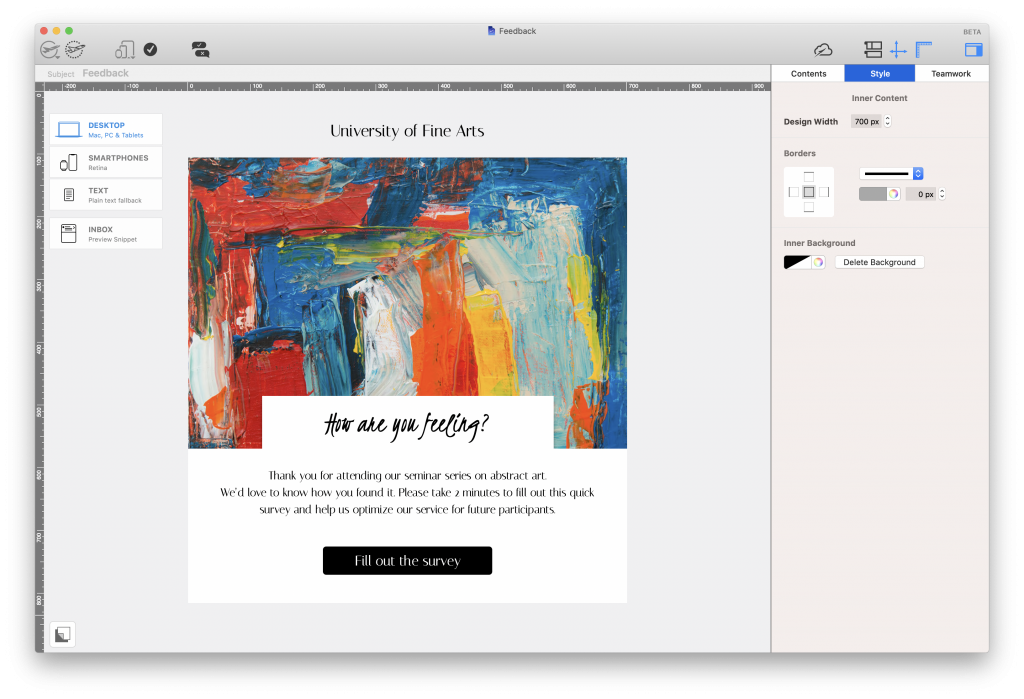
Use email campaigns to showcase your institution’s strengths. Highlight upcoming open days, academic programs, research breakthroughs, or student success stories to stand out from the competition.
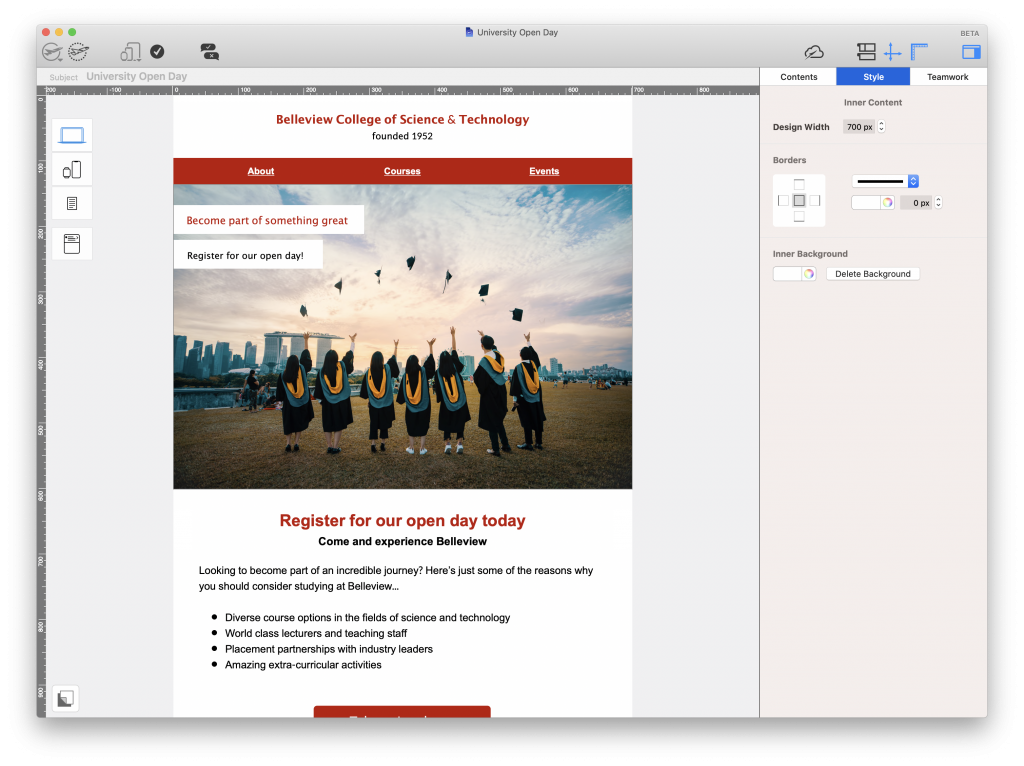
Stay connected with your alumni community by sharing success stories, event invites, or giving opportunities. Since graduates often move, email is a more reliable channel than postal mail.
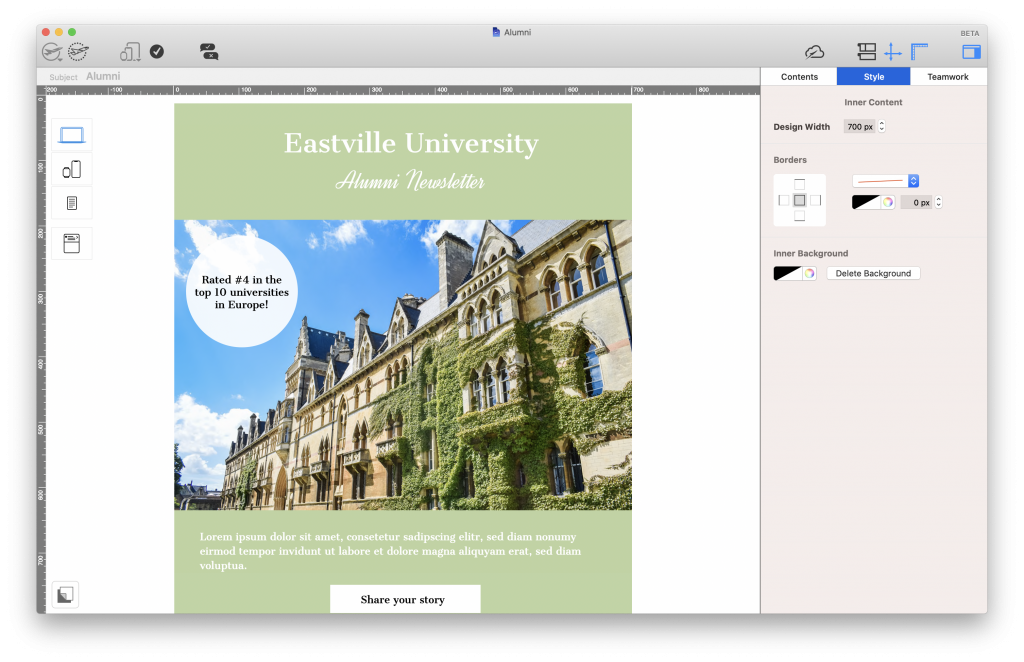
Once you’ve chosen your email campaigns, follow these design and content guidelines to ensure your emails look professional and perform well.
With a drag & drop email editor like Mail Designer 365, you can build professional email templates for your school or university in minutes. Start with a blank canvas or choose a Design Idea from our selection of email templates for education.
Every email you send on behalf of your institution should conform to your brand guidelines. Not only does this make it easier for recipients to recognise that the email has come from you, it also helps you to protect your reputation.
Start by inserting the logo or crest for your school in a prominent place in your design. Usually, this would be the email header. You should also keep other aspects such as the font family and color scheme consistent at all times.
Tip: In Mail Designer 365, you can save your logo header under "My saved blocks" to reuse in all future email designs.
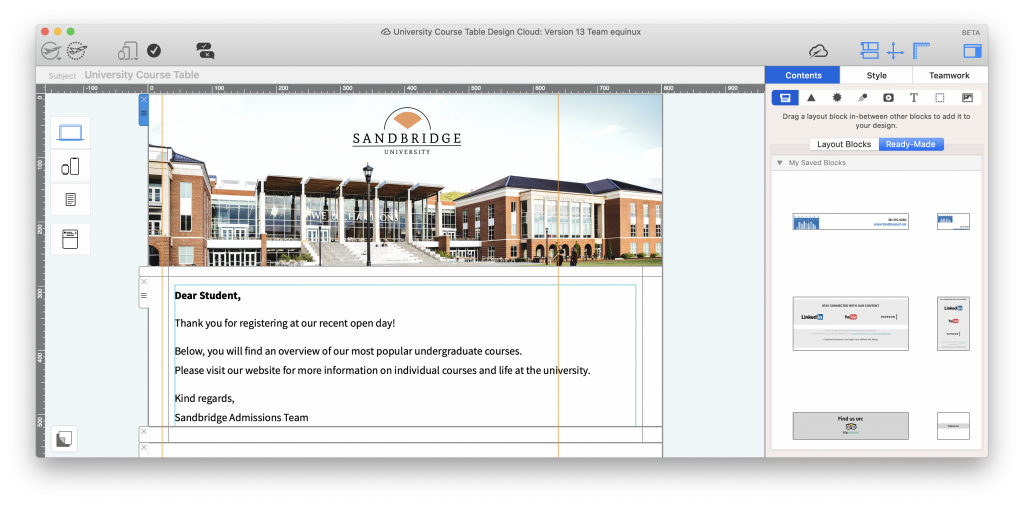
Especially when you are presenting large amounts of information to your readers, it's important to opt for a clear layout. There's nothing worse than trying to navigate your way through a cramped email to locate what you're looking for.
Be sure to use a healthy balance of text and images and use spacers and headlines to separate different sections of your email.
Tip: Mail Designer 365 offers you a wide range of layout options, including mobile-responsive table layouts, which you can use to clearly present important information.
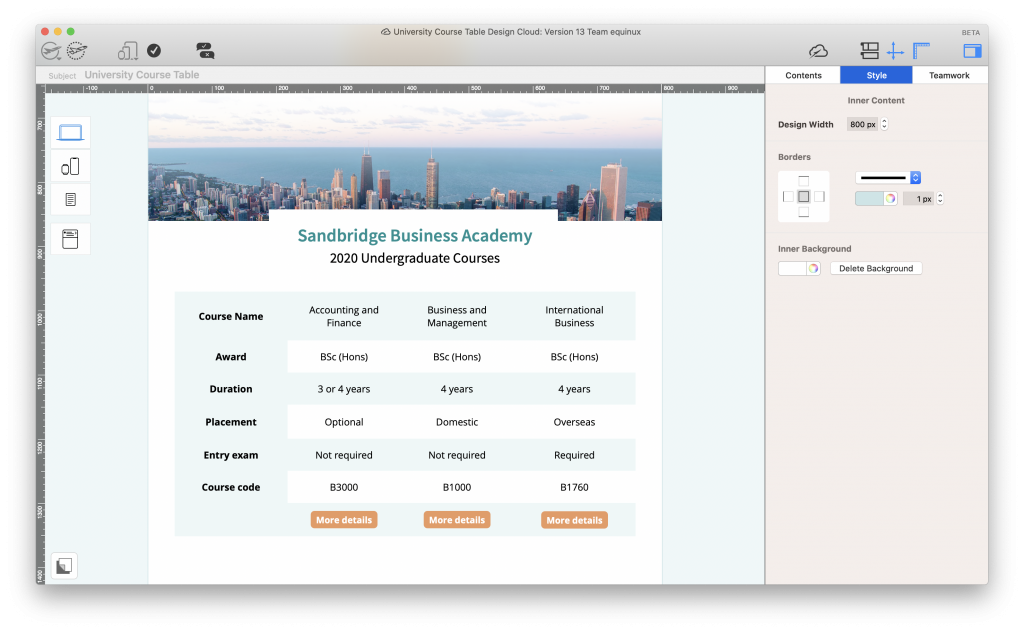
When putting together your emails, it's also best practice to consider your target group. This will help you determine the tone you use in your email copy, as well as other important style elements, such as graphics and eye-catchers.
If you are creating email content for a younger audience (i.e. high-schoolers or college students) it's generally fine to use a more relaxed tone and even shake things up visually, e.g. with GIFs, memes, emojis, etc.
On the other hand, if the email is intended for a different audience (i.e. parents, governors, etc.), or you are sharing important information, it's best to keep the tone more formal and to refrain from any style elements which may distract from your key message.
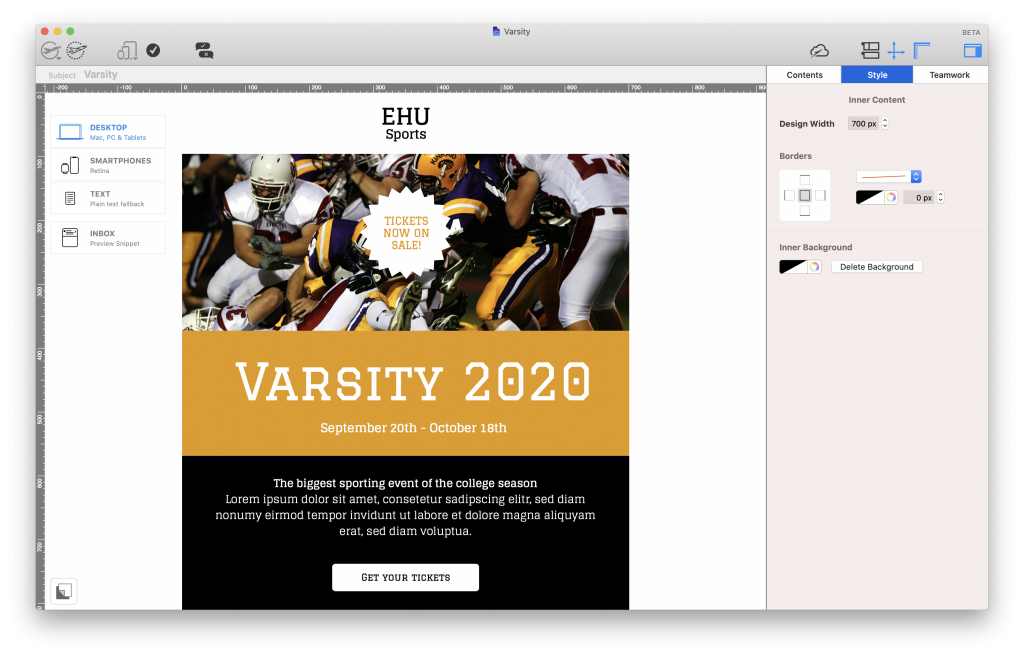
Including a call to action (CTA) in your email helps point the recipient towards their next steps. This does not have to be sales-related! Here are a few examples of CTA links you can include in your institution's emails:
Whatever you opt for, you should ensure your CTA stands out well against the rest of your email and that the text is clear and concise.
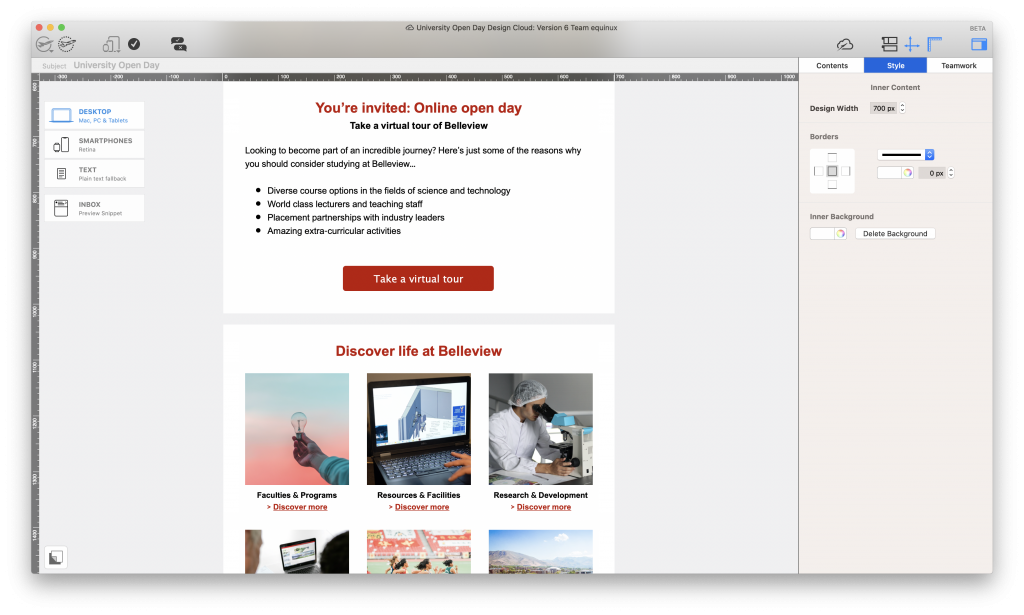
We hope you’ve found this email guide for schools and universities useful and will consider applying some of these tips to your own email strategy. Getting started with email marketing for your institution is easy and affordable:
Until next time,
Your Mail Designer 365 Team
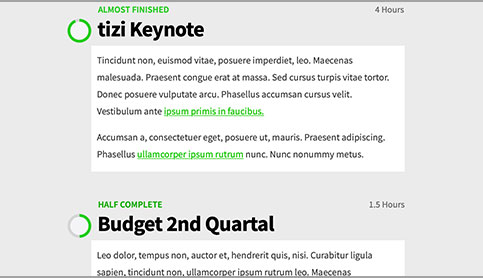
Although often overlooked, creating an engaging company newsletter is a highly effective way to bring your team closer together and improve your company's image.The main purpose of a company newsletter is to share the most important news and announcements with your employees, shareholders, and perhaps even customers, but this doesn't mean it has to be boring and monotonous...
Here are our top tips on building effective company newsletters which your employees will want to read.
A consistent company newsletter keeps your team informed, aligned, and engaged. It’s an easy way to share updates, recognize achievements, and reinforce your company culture — all in one place. Whether you’re announcing new projects, celebrating milestones, or sharing leadership insights, a newsletter helps build stronger internal communication and a more connected workplace.
Depending on the size of your organisation and the type of news you're looking to share, you may not be able to adopt a "one size fits all" approach with your company newsletter. Before you begin to create your newsletter content, think about who you want to send it to, and why. This will help you identify the tone you need to use and what you should include to make it more relevant for the target audience. Here are a few suggestions:
Once you've identified which kind of newsletter you want to send, you can start planning the content you want to share with your readers. Try and identify a key story or topic which you can use as the main theme of your email to help draw your readers in. You can also use the email subject to immediately communicate this theme to readers and increase the chances of your email being read.
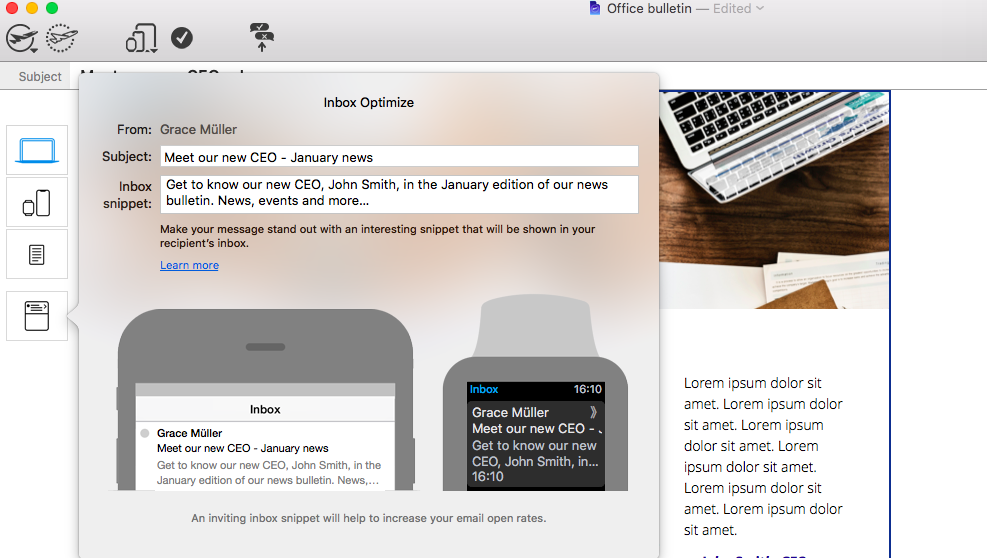
Decide on a main newsletter theme and include in your subject line to draw readers in.
As a manager or team leader, you can use your company newsletter to speak to your whole team on an informal level. This is especially important if you have a larger team you don't get to interact with often. By keeping the tone friendly and conversational, you will come across more approachable to team members and employees.
The key to building up a good email layout is to include a balance of text and images. This breaks up your email and makes it much more appealing to readers. In Mail Designer 365, there is a wide variety of layout options to help you build a newsletter which looks professional.
For example, for longer news stories, you can use a 4-column layout block to create a more authentic magazine style layout:
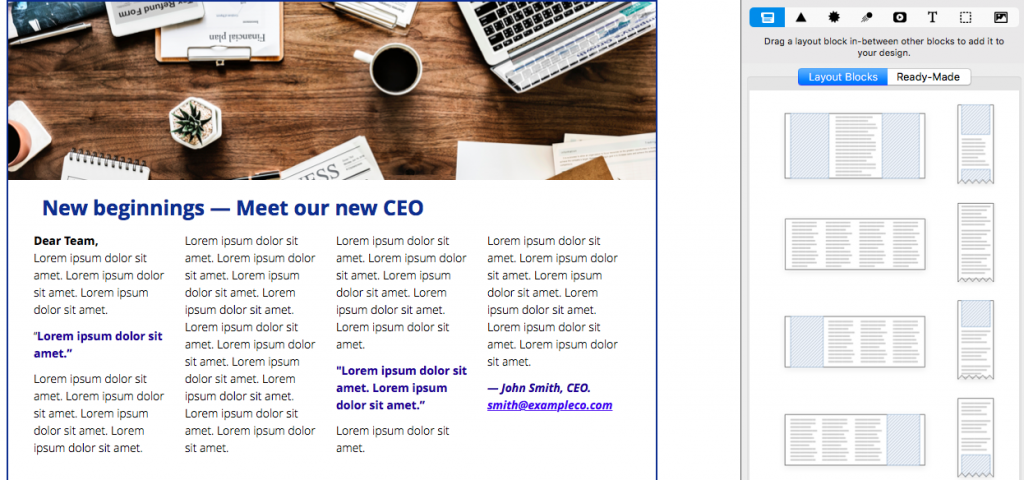
Use the 4 column layout block for longer news stories.
For images, you can choose between a large, attention-grabbing central image, or save space by grouping together smaller images with informative captions:
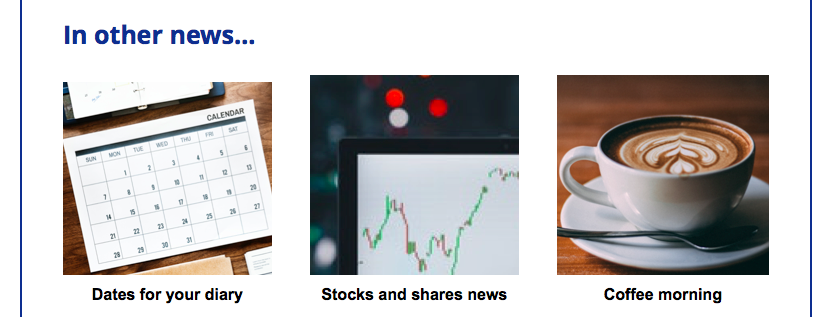
Features such as employee of the month are a great way to boost morale and praise good work. Sharing good news with your colleagues is another way to keep spirits high. However, you should also remember to stay positive during difficult times. If your team is under-performing, use your newsletter as a way to motivate them to do better.
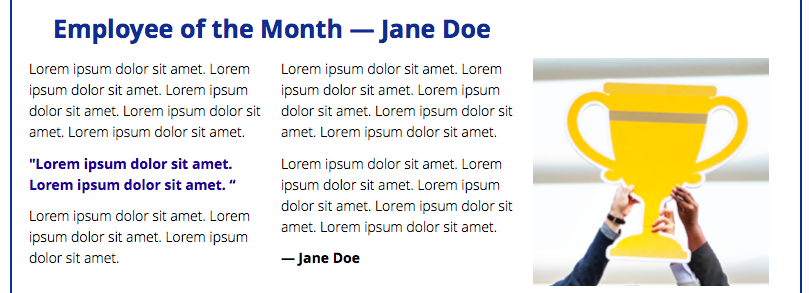
Features such as employee of the month are a great way to boost morale.
You should try and keep newsletters as consistent as possible so your readers know what to expect. This includes aspects like the color scheme, newsletter title, font, and layout. You could also include regular features like quotes, event calendars, or a comic strip to keep readers engaged. By sticking to a trusted format, you also have a reliable template for future designs.
Tip: You can build one master template in Mail Designer 365 which you can duplicate and edit whenever needed. This way, you keep a consistent style and don't lose your formatting.
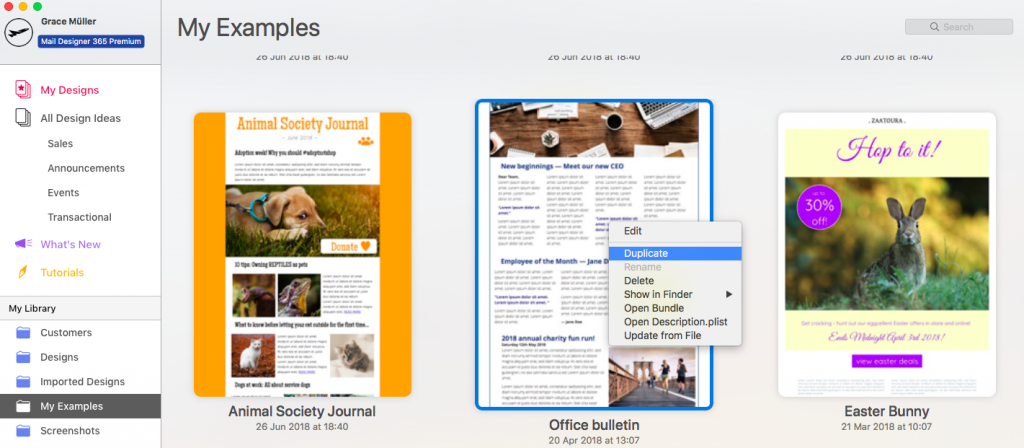
Duplicate newsletter templates to keep your styles and formatting for next time.
Whether you are a small business, a large corporation, or a smaller team within a big organisation, you should be able to find a sending schedule which suits you. Although this doesn't have to be exact, it is good practice to establish some sort of pattern so you are keeping in regular contact with your employees or shareholders.
We hope you found these tips for building a company newsletter useful. Remember, you can try out these tricks in Mail Designer 365 by downloading the app free from our website!
Until next time,
Your Mail Designer 365 Team
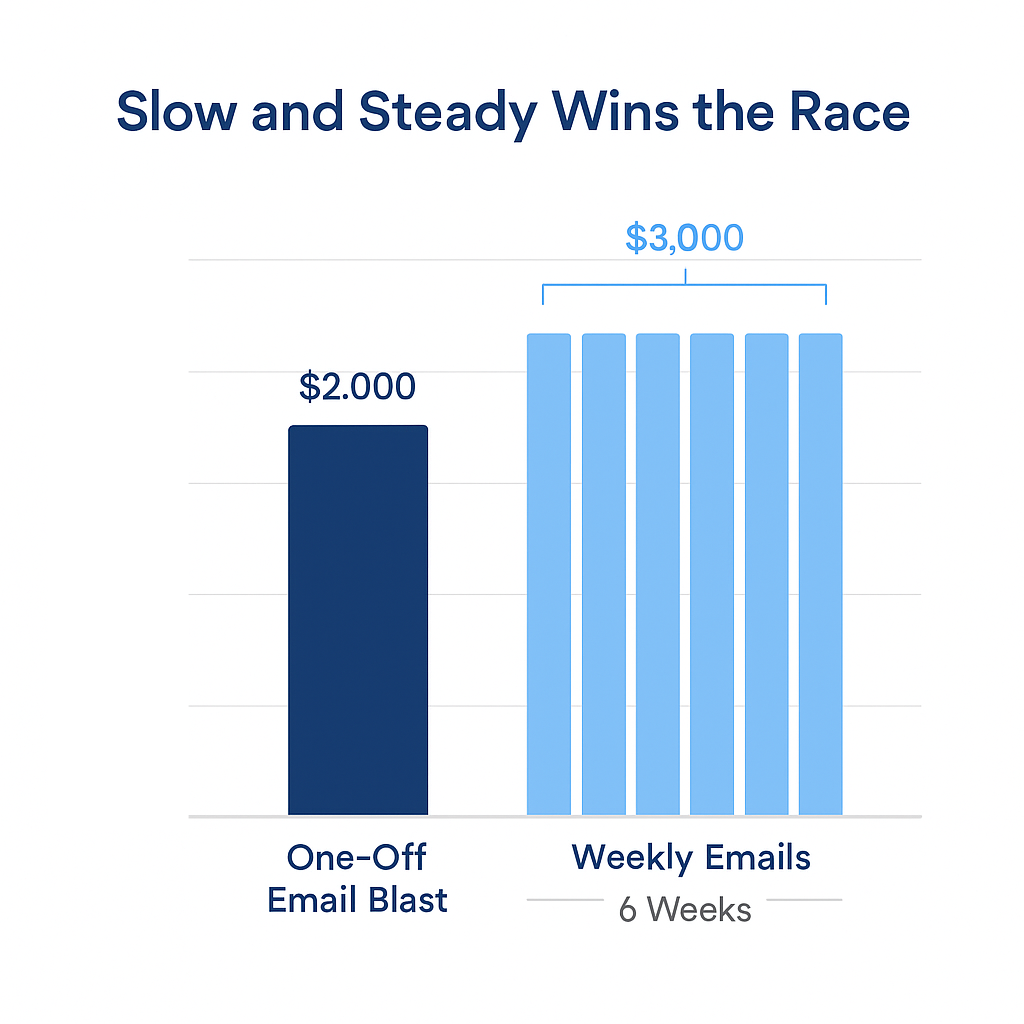
When it comes to email marketing, it can be challenging to find the time and motivation to stick to a consistent schedule (especially for small business owners juggling a hundred other tasks!) But here’s the thing: research shows that brands sending out emails weekly generate more than twice the revenue of those that send less frequently, making a consistent email schedule a no-brainer for your business.
In this post, we’ll break down five key benefits of sticking to a consistent email routine, plus share practical tips to help you send more regularly without adding extra stress to your plate.
In email marketing, visibility is everything. You can't expect results if your brand doesn't consistently show up. By sending emails regularly, your brand will become much more prominent in your subscribers' inboxes, creating a sense of trust and familiarity for your messages.
Think about the key brands you see in your inbox each week; they're usually the ones you regognize immediately, right?
In contrast, the brands who are sending less frequently tend to go unnoticed. Subscribers may not even remember signing up to your list to begin with. This uncertainty often leads to genuine senders being marked as spam.
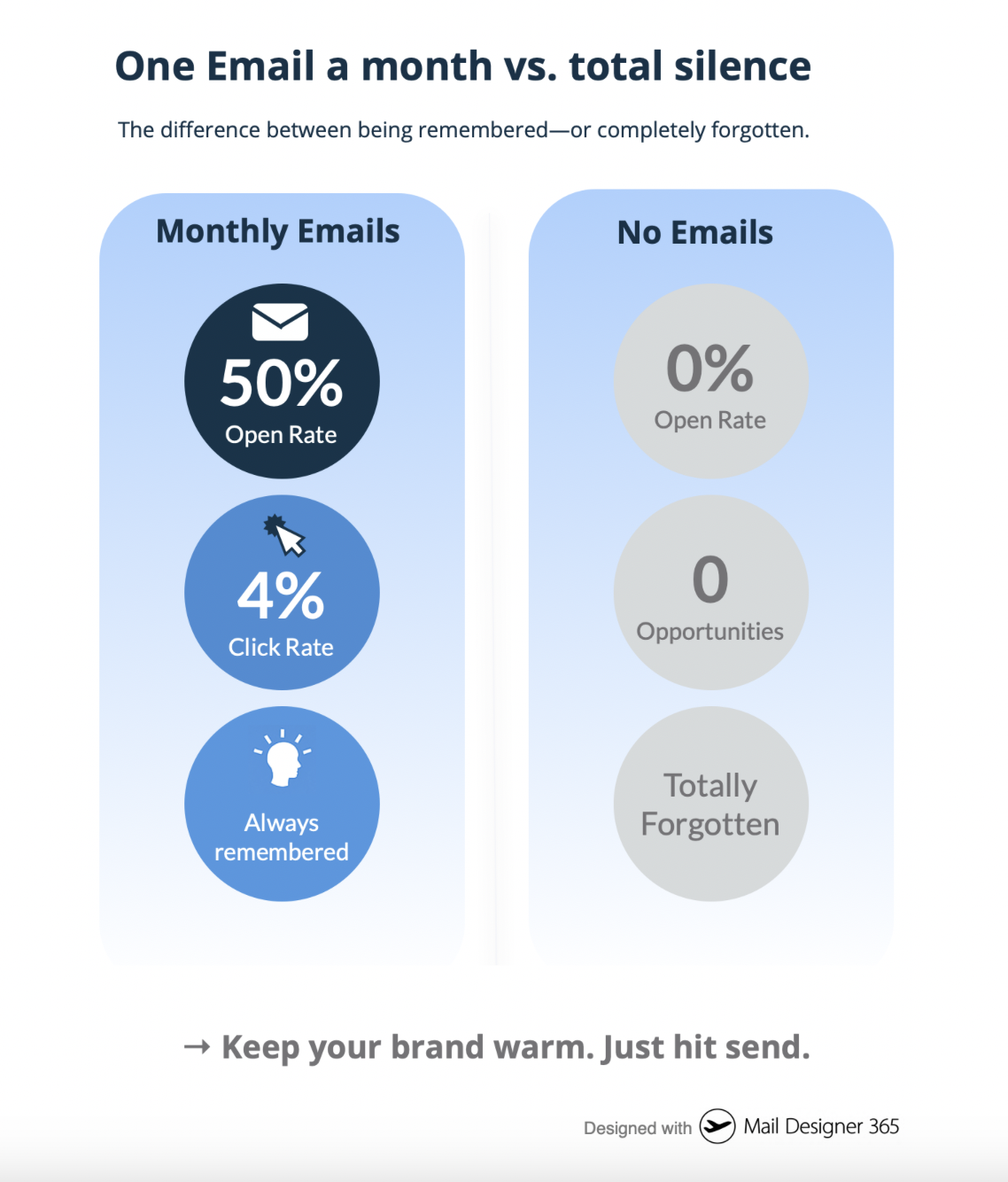
Once your subscribers become familiar with your brand, regular emails create anticipation. If you're sending emails consistently (especially at the same time each week) your audience will begin to expect them.
For example, Netflix regularly send out weekly top 10 emails, showcasing the most popular titles on the platform. Subscribers are familiar with this format and will be prepared to engage and click through to watch the trailer or start the show.
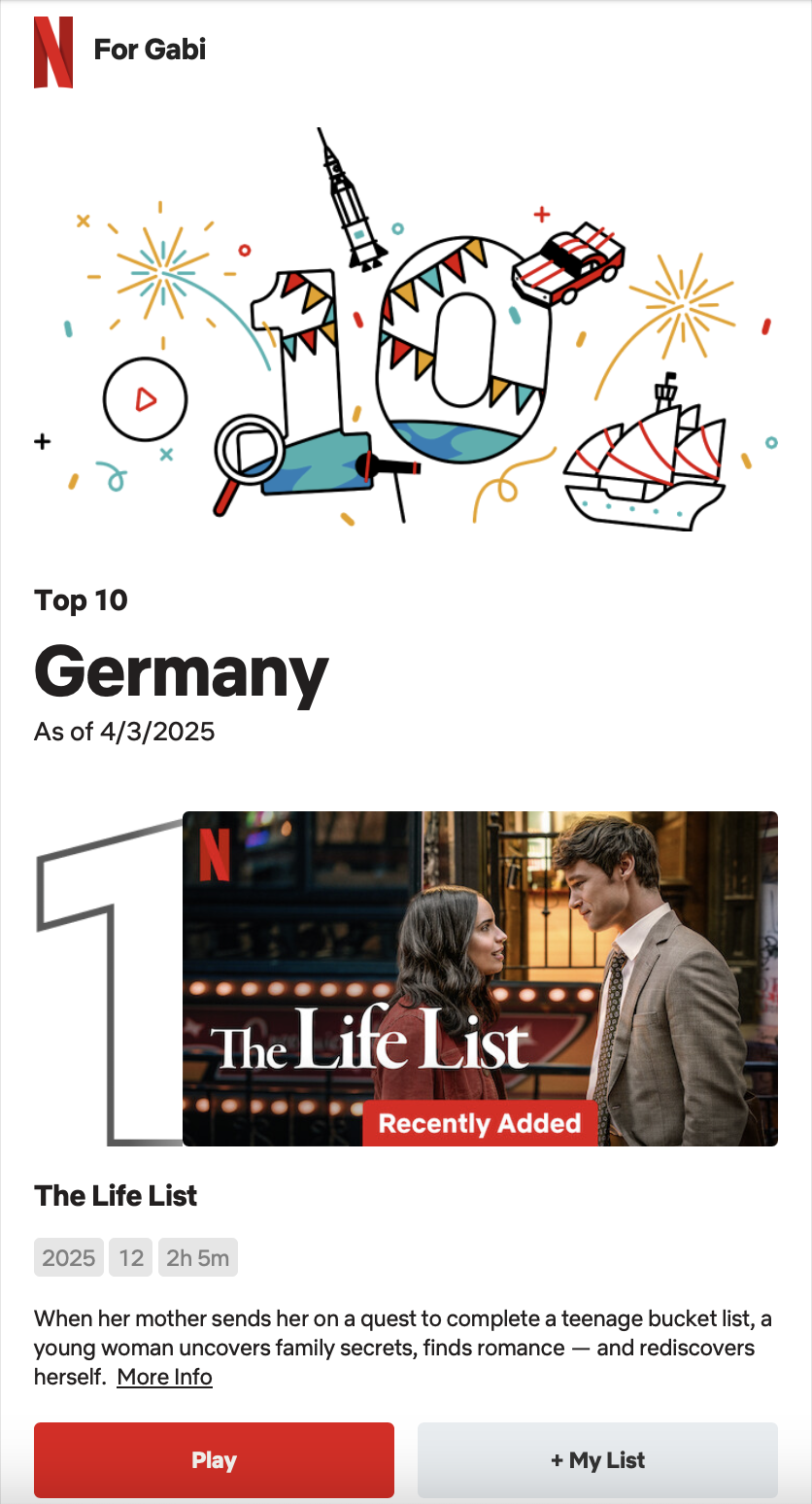
A similar concept for your brand could be "Deal of the Week" or "Hot Right Now" (i.e. for trending products.) These campaign ideas help you keep email content fresh, relevant, and easy to engage with, without having to come up with something new every time.
It's a common misconception that sending emails frequently will get you flagged as spam. In fact, sending regularly can actually improve your sender reputation – if done right.
Email providers are known to track how often you send and how your recipients interact with your emails. If platforms like Google and Outlook see you are consistently sending high-quality content to subscribers - i.e. emails that are being opened and clicked by recipients - this works in your favour and shows you are a trustworthy sender.
On the other hand, sporadic or unpredictable sending habits can raise red flags. If your emails suddenly appear after weeks or months of silence, providers might treat them as suspicious, potentially harming your domain's reputation and pushing you into the spam folder. Worst case? Too many spam flags could get your brand blacklisted by major providers—resulting in zero exposure and a lot of hassle trying to recover your sender reputation.
Most email marketers know the earning potential of a well-executed email campaign. And while quick, last-minute blasts can result in the occasional traffic spike to your website, a healthier approach is to use email to drive more customers to your site and create a more reliable revenue stream over time.
Think of it this way: sending one big promotional email every 6 weeks might generate $2,000 in sales. But what if instead, you sent smaller, more targeted emails once a week? Even if each of those brought in just $500, you’d generate $3,000 over the same six-week period, and get six opportunities to engage with your audience instead of one.
Not only does consistent sending help grow your revenue more sustainably, it also strengthens customer relationships and helps you reduce your reliance on high-pressure, last-minute campaigns.

Data is key in understanding your audience – an important goal for any marketer. The more you send over time, the easier it becomes to know what works for your subscribers and what doesn't.
Let's say you are getting a typical click-to-open rate (CTOR) of 12.5% on your weekly emails. This week you try a new format and your CTOR jumps to 15%. Because you have been sending regularly and have the analytics data, you can instantly see that your change was received well by your audience.
However, if you had only been sending emails sporadically, a subtle change like this would have been harder to detect and also not as easy to trust.
In short, regularly sending emails gives you a better insight into what your audience likes, allowing you to create higher quality content and drive engagement and revenue over time.
Now you have an idea of the benefits that sending more often can bring to your business, let's explore a few small changes you can make to help yourself keep on top of your sending schedule:
If you're new to all this, one email a week might seem like a lot! Don't panic - start off with bi-weekly emails and then work your way up to weekly when you start feeling more confident. Remember it's quality over quantity.
Set aside one or two days each month to prepare all your email content for the next few weeks. This helps reduce the pressure and means you'll always have something ready to send.
A planner or calendar helps you jot down ideas and key dates in advance so you're never left without inspiration for an upcoming campaign.
If you're strapped for time, you'll probably find you have an existing blog post or old newsletter that you can tweak and recycle into something new in no time at all!
As touched upon earlier, creating a few reliable concepts (e.g. product of the week) that you can reuse helps you to send content regularly while still staying fresh and relevant.
As soon as a campaign is prepared, use your platform's scheduling tools to get it all set up and ready to go. This way, you won't forget to send it out if you have too much going on on the day!
Tip: Mail Designer 365 lets you schedule email content weeks in advance – super useful if you know you have a lot coming up or if you're going away on vacation but still want to make sure your emails are going out. You can even manage campaigns on your smartphone.
We hope this post has demonstrated how regularly sending emails can benefit your business and what small steps you can take to up your email volume!
Want to get started right away? Mail Designer 365 is your perfect companion: from building your first email template, all the way up to sending to your subscribers. Try it out free for 7 days on your Mac and start transforming your brand's email marketing strategy.
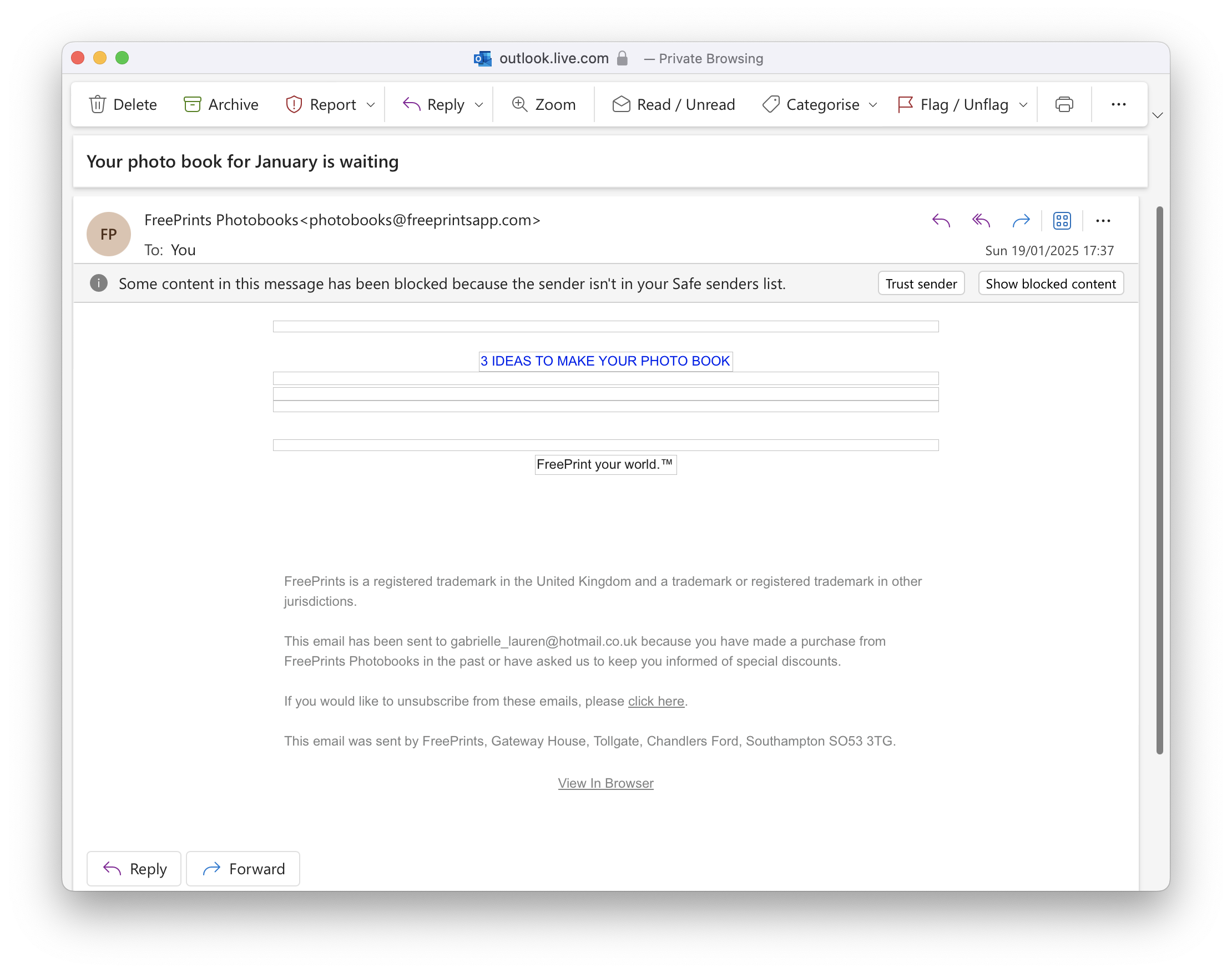
Picture the scene: You’ve spent ages designing the perfect email, only to hit send and realize it looks completely different in your recipients' inbox. Is there anything more frustrating?!
Email rendering issues are more common than you think – especially with so many different email clients and devices out there. From missing images and broken layouts to dark mode fails, these display problems can majorly affect your email's success rate and even land you in the dreaded spam folder!
Using a dedicated email template creator that’s built for responsive design is a smart first step toward preventing these kinds of issues.
In this guide, we’ll walk you through some of the most common email rendering mistakes and share expert tips on how to avoid them so your emails always look great, no matter where they’re opened!
As the old saying goes, "a picture speaks a thousand words". These days, HTML emails and images go hand in hand, and for good reason: adding images to your email design makes it much more interesting to read and gives you the chance to showcase products directly within your newsletter. Unfortunately, missing images are one of the most common email rendering issues and can completely break your design if not handled correctly.
However, many email clients now block images by default, either to save data (a common feature on mobile devices) or to protect users from potential spam. For example, Gmail and Outlook often display a "Show blocked content" message, leaving a blank space where your carefully crafted visuals should be. Learn more about how Outlook handles automatic picture downloads here. This is a classic example of email rendering issues that every marketer needs to anticipate.
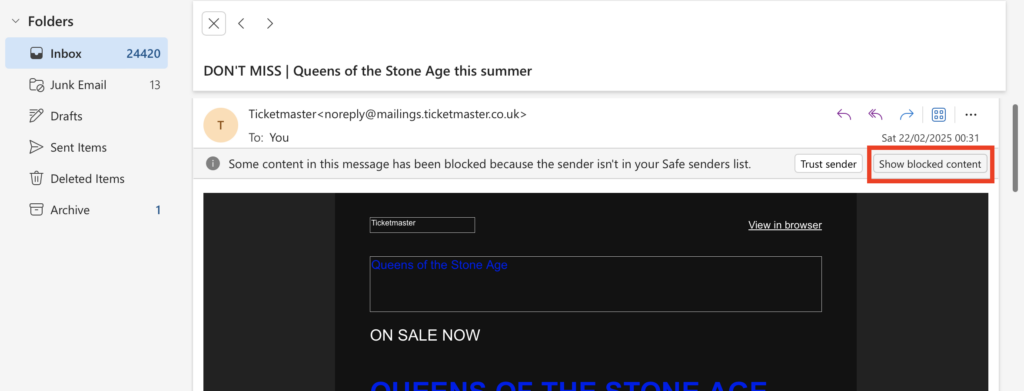
Image blocking in Outlook
If your email largely consists of or is heavily reliant on images, here are some important things to consider to avoid serious email rendering issues:
Emails that are 100% image-based or too image heavy are much more likely to be caught out by spam filters, as these look for a high ratio of images to text as an indicator of suspicious or unsolicited messages. Furthermore, even if they do get through, if the images are not rendered, your recipients will end up seeing a blank email with no content — a critical rendering issue that can destroy engagement.
Generally, it's recommended to design emails with a 60:40 text to image ratio.
This email from FreePrints is a clear example of why image-heavy emails should be avoided at all costs. All of the main content is image-based and therefore completely invisible in the email client, showing how quickly email rendering issues can harm campaign performance:
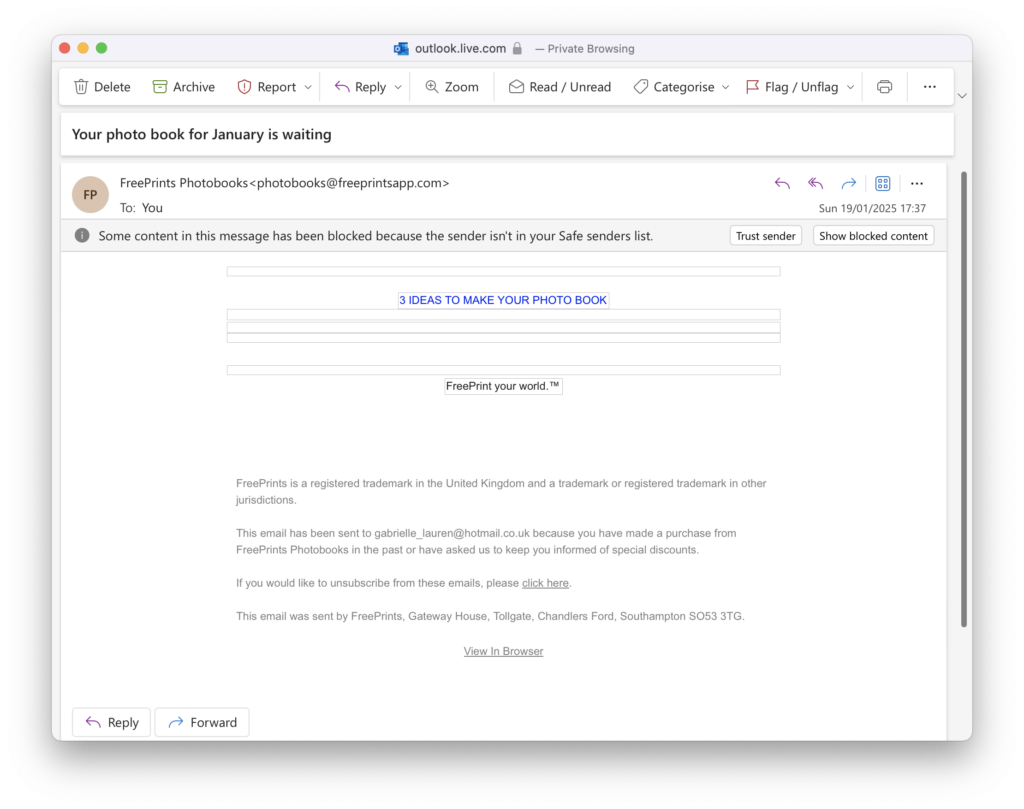
Here's how the email should look once rendering issues are resolved. Big difference!
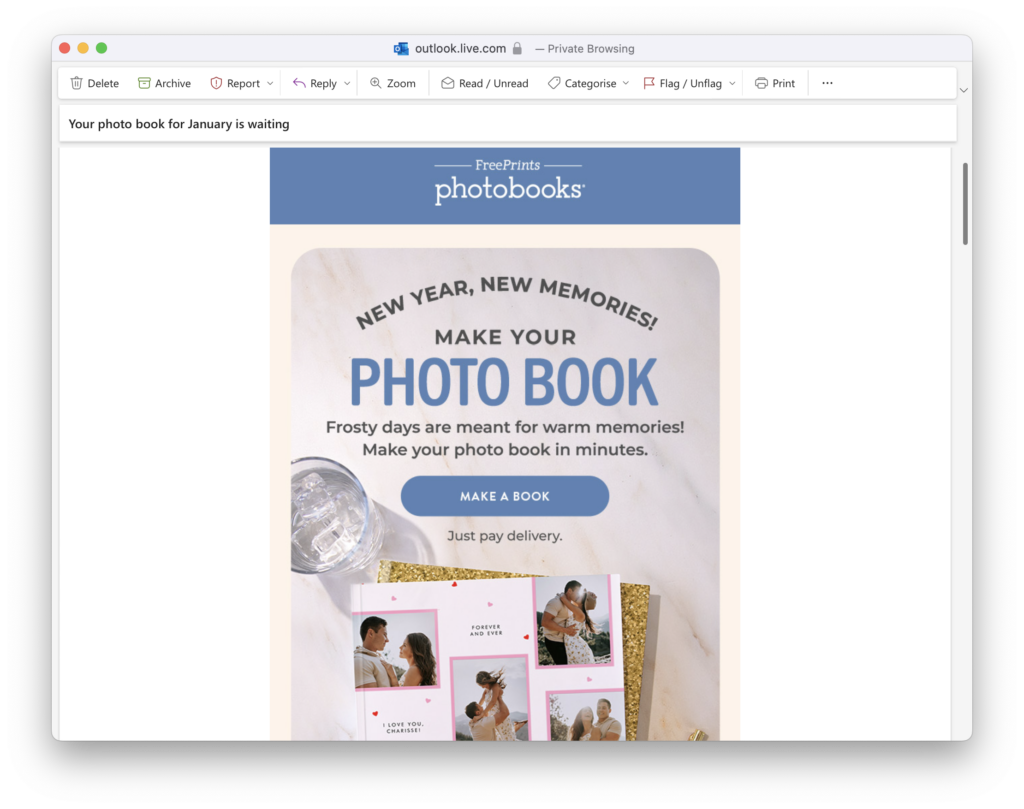
Of course you can't completely avoid images in your emails and nor should you! Including alt text is a great backup plan in case your images aren't rendered correctly. This helps prevent email rendering issues from leaving users with a blank message. Alt text is a short, descriptive text that appears in place of an image when it can't be displayed, giving you the opportunity to describe the gist of your image to recipients. Not only that, it's also best practice for accessible emails and ensures users with screen readers are also able to consume your content effectively.
Check out this example from Ryanair. The main message and selling point of the email "Flights from €16,99" is completely image-based:
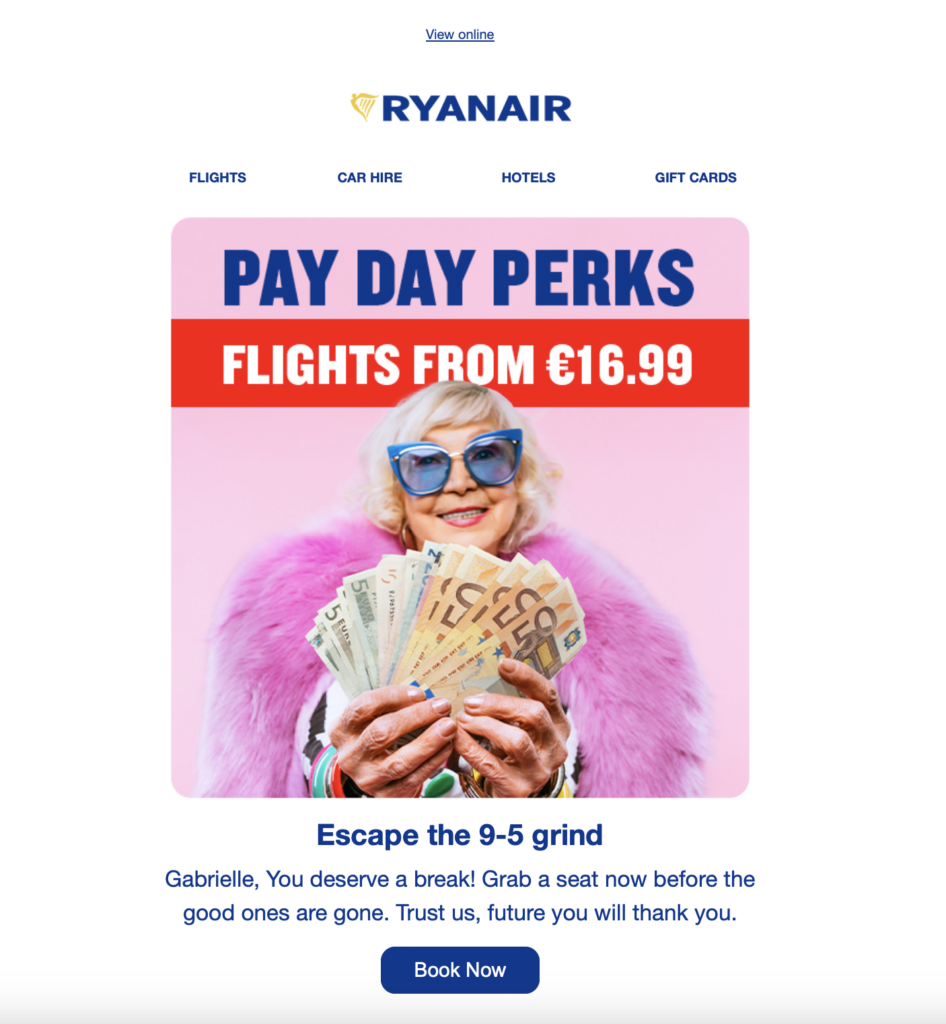
However, when images are deactivated in the email client, this is completely missed out — another major case of email rendering issues:
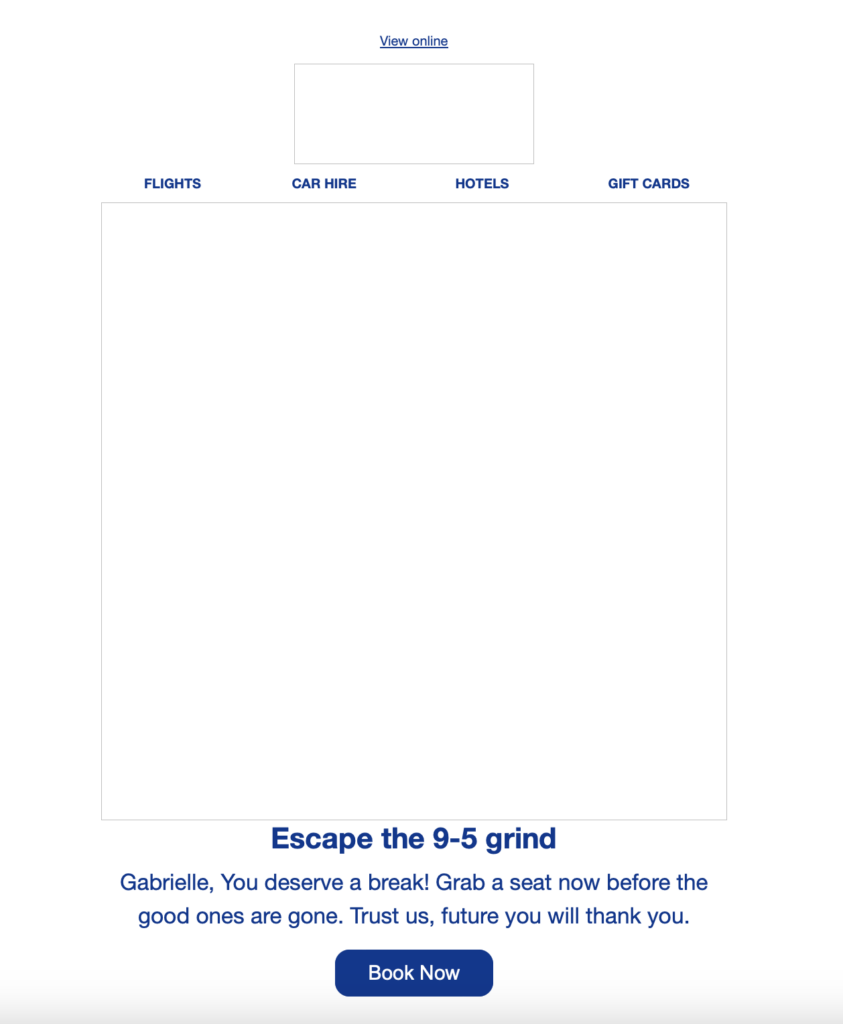
If an alt text had been used here, a much higher percentage of their audience would have seen the low prices and been more likely to click.
On the other hand, this email from Bunches shows how to correctly use alt text in your email designs to overcome email rendering issues:
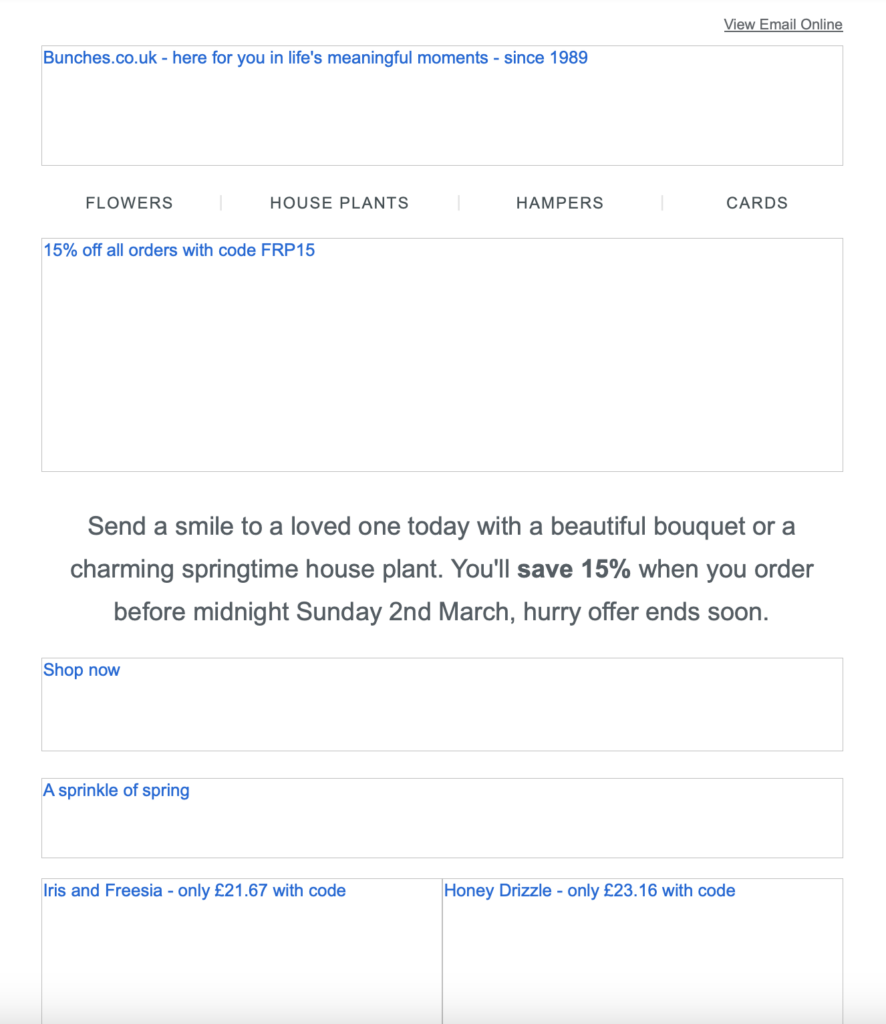
Learn how to add alt text to image areas in Mail Designer 365 →
If your email's main call to action (CTA) is image-based, you’re taking a risk. Images may not render in all email clients, meaning a large chunk of your recipients might not see your CTA at all. When that happens, your click-through rate and overall campaign success will likely suffer due to rendering issues.
The solution? Use text buttons in place of image-based buttons– especially for important call to actions like "buy now", "download", "shop the sale", etc. This ensures that your recipients will always be able to see your CTA, regardless of whether images have been loaded or not.
Although some senders only opt to add an alt text to their image-based button, text buttons give you the best of both worlds: guaranteed rendering and great visuals. Mail Designer 365 allows you to easily insert text buttons into your emails and perfectly style them to match your design. Here's how it works →

Inserting a text button in Mail Designer 365 is easy
Since dark mode gained popularity around 2018, many email marketers have encountered rendering issues due to the way different email clients handle content in dark mode. Take Gmail, for example: in dark mode, it adjusts brightness to improve readability, which can result in white backgrounds turning dark gray, and dark text turning lighter. This is particularly problematic for designs with black text on a white background (or vice versa), as it can make your carefully crafted email copy difficult or impossible to read!
The solution? Stick to color schemes and design practices that will be legible in both dark and light mode, ensuring your message gets across clearly regardless of the user’s display settings.
These days, more emails are opened on mobile devices than on desktops, so getting your mobile layout right is crucial. If your email isn’t optimized for smaller screens, you risk broken layouts, unreadable text, and a wasted email campaign that doesn't hit the mark with your readers.
One of the biggest culprits? Fixed-width designs. If your email is too wide and doesn’t adapt to different screen sizes, mobile users will be stuck zooming and scrolling sideways just to read your content. Another common issue is tiny, hard-to-tap buttons—if a recipient has to pinch and zoom just to click your CTA, chances are they won’t bother.
Mail Designer 365 has a separate mobile editor to ensure fully responsive email design. Here are some helpful ways Mail Designer 365 ensures your email also looks great on mobile:
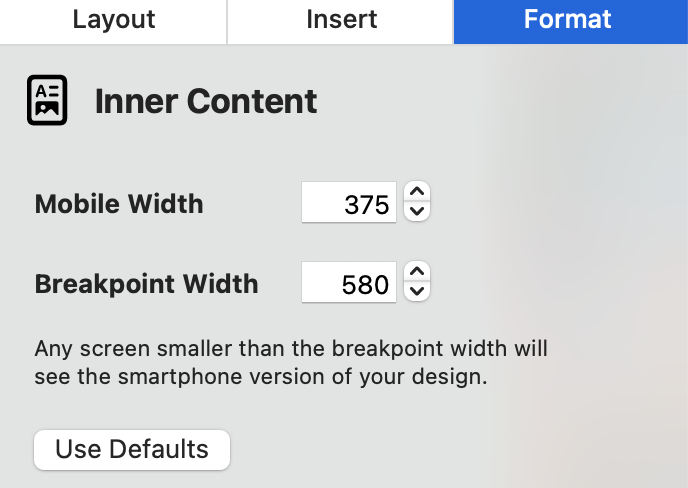
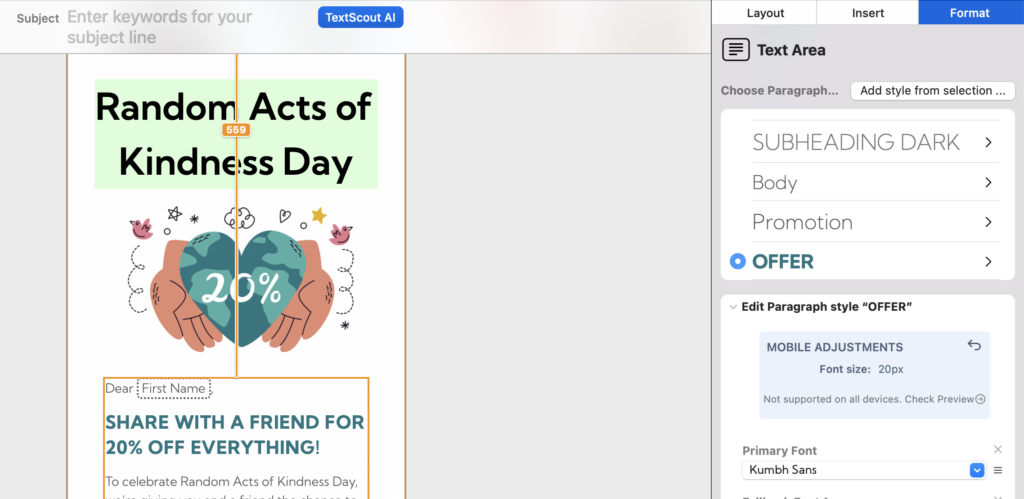
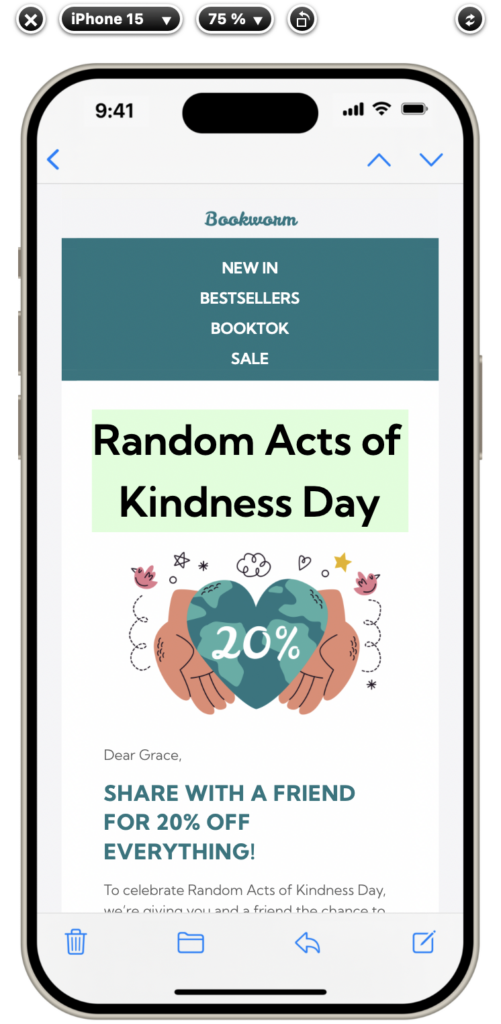
Certain email clients – including Gmail – impose strict size limits for emails. Once an email reaches a certain size, it will be clipped, meaning emails over that size will not be completely rendered. For example, in Gmail the size limit is 102kb and in Yahoo it's 100kb. This is one of the lesser-known email rendering issues but one that can seriously impact campaign performance.
Email clipping is especially problematic if you have important information or call to action links at the end of your email, as this content may be missed by your recipients. Furthermore, if your disclaimer containing the unsubscribe link is clipped, this could even result in legal issues and damaged deliverability — another major side effect of email rendering issues.
Here are some quick tips on how to reduce email size and avoid clipping-related rendering issues. For more detailed information, check out this guide.
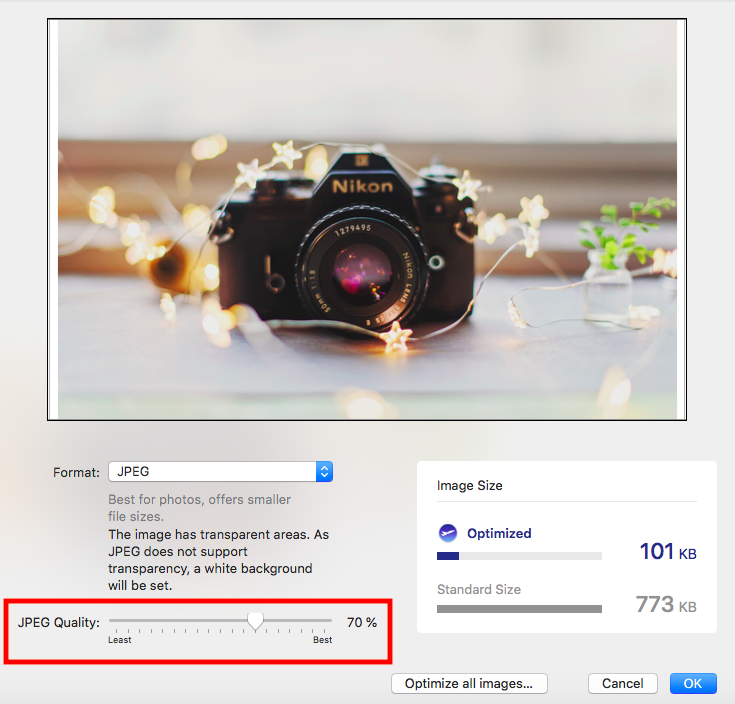
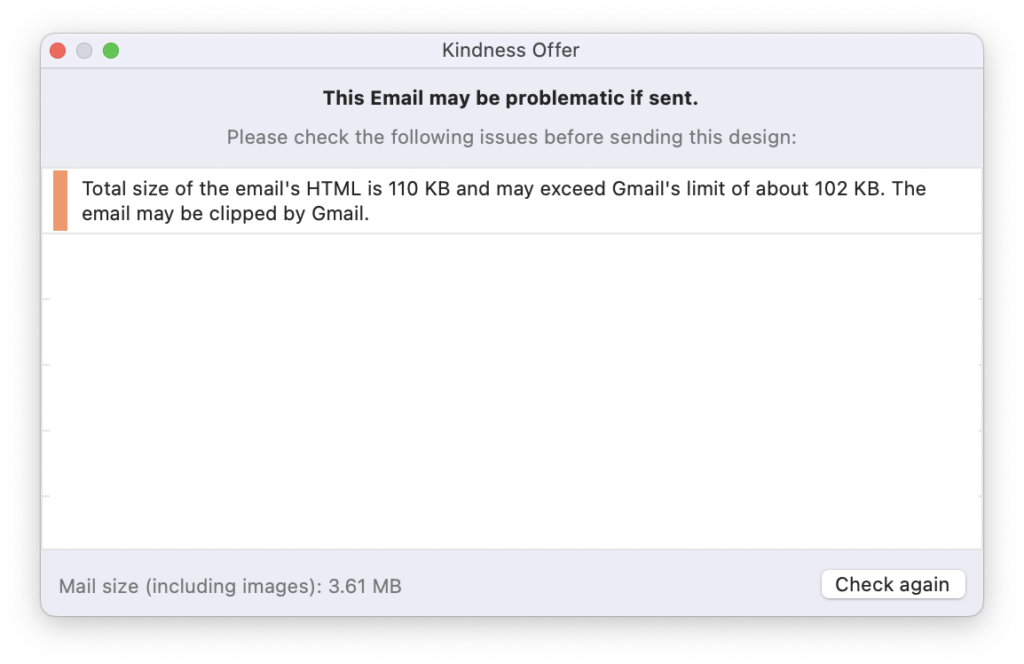
We hope you found these best practice email design tips useful. Try them out in your next newsletter to ensure your email campaign doesn't fall victim to common email rendering issues!